



NANTOU COUNTY Yushan National Park The Town of Puli Three Themed Tours Website issuu No. 123 2024 MAY & JUN GOOD FOOD HAKKA CUISINE RESTAURANTS URBAN WALKS TAICHUNG’S CALLIGRAPHY GREENWAY EXPERT TALK SELECT SHOP EARTHING WAY

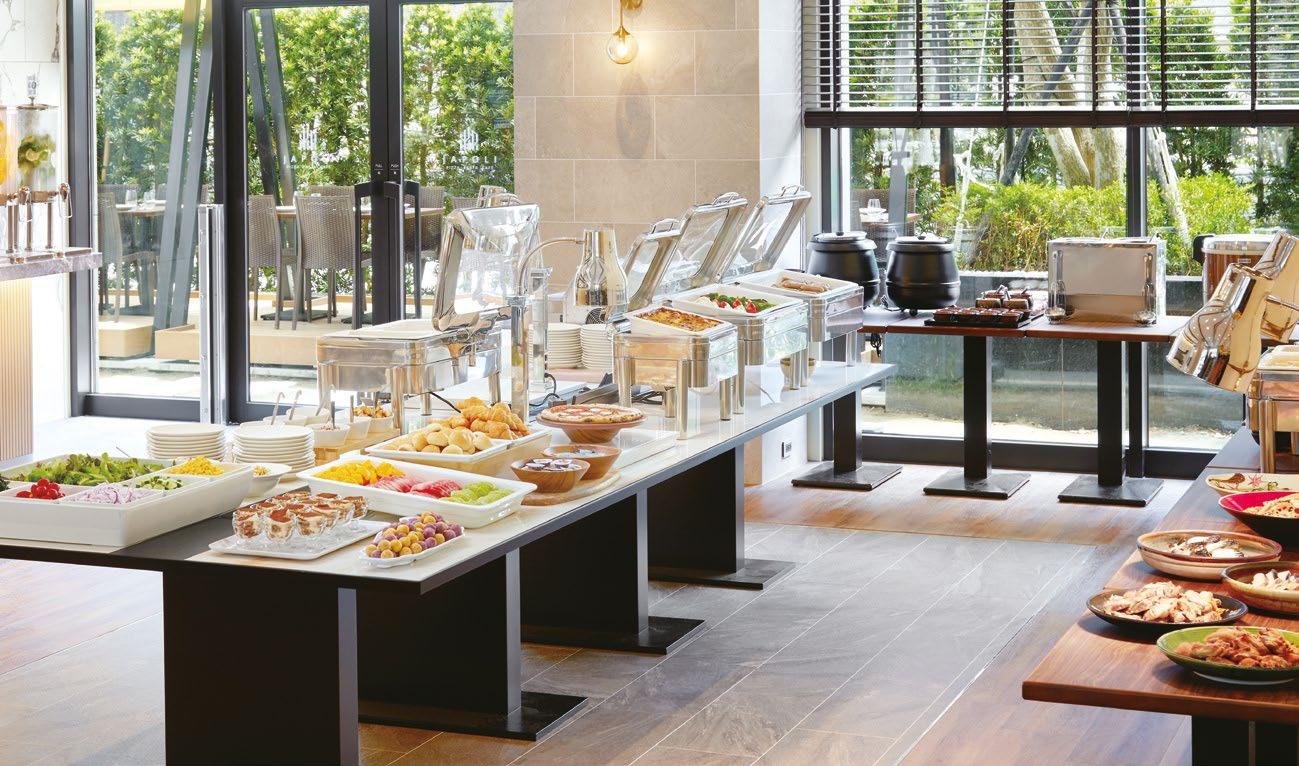
The first hotel of the Mitsui Garden Hotels chain outside Taiwan






Enjoy a combination of Character and Quality! Taiwanese Japanese Add: No. 30, Sec. 3, Zhongxiao E. Rd., Da'an Dist., Taipei City (台北市大安區忠孝東路三段30號) Tel: +886-2-2781-1131 Facebook Instagram Web
A new Taipei landmark, MGH Mitsui Garden Hotel Taipei Zhongxiao has an interior design inspired by Taiwan’s natural beauty with artwork created by Taiwanese designers. The guestrooms are relaxing spaces that stand out for their exceptional Japanese quality. On the top floor you will find a Japanese-style bath area with breathtaking views of the city. Enjoy a delicate buffet breakfast prepared with carefully selected fresh ingredients from Taiwan. Conveniently situated just a few steps from Exit 3 of MRT Zhongxiao Xinsheng Station (Blue and Orange lines).
Dear Traveler,
It’s May, and Taiwan is most definitely “heating up” as a travel destination – the more intense subtropical heat of early summer is arriving, making all time spent outdoors while exploring this island world even more comfy.
You can still enjoy some mountain cool, however, with a sojourn to Nantou, Taiwan’s only landlocked county, a beloved vacation-getaway mountain fastness. This issue’s bigadventure feature article gets you to poetically scenic Xinyi Township in the county’s southernmost reaches, which our writer describes as a “gateway to the sky.” This is home to iconic Mt. Jade (Yushan), northeast Asia’s highest peak, within majestic Yushan National Park, which has superb hiking trails suitable for any traveler of moderate fitness. We take you out on one of these hikes.
In two accompanying Nantou County offerings we present a “themed tours” general overview of how you can discover the county from different angles – cycling, railway, and high-mountain exploring – and introduce Puli Township, in its northwest. In the overview, it’s breezy bicycling around romantic Sun Moon Lake, a train outing on the river-valley Jiji Branch Line, and soaring highlands visual canvases at Qingjing Farm and Mt. Hehuan (Hehuanshan). The touristwelcoming town of Puli, in a cozy mountain basin, is a
popular stop for travelers on the way from central Taichung City on the western plains into Nantou’s deeper reaches.
Central Taichung itself stars in our regular Urban Walks file. A place of numerous green corridors, this is one of Taiwan’s most pleasant urban cores to tour on foot, and we recommend a basketful of popular attractions along and near the long Calligraphy Greenway, lined up in morning/afternoon/ evening itineraries.
Elsewhere, in this issue’s Good Food and Expert Talk segments you’ll be enjoying unique experiences in the north, in the capital Taipei. The Hakka people are one of Taiwan’s most visible minorities, in the past primarily inhabiting rural and mountain settings. First-rate Hakka fare is readily available in big-city Taipei, and in Good Food you’ll sit down to feast on introductions to three of the top local Hakka eateries. And in Expert Talk you’ll discover the fine-crafts select shop Earthing Way, where the concepts of “rural revival aesthetics” and “Taiwanese-style wabi-sabi” are celebrated.
Interest piqued? Come experience the warm embrace of the early Taiwan summer!
TAIWAN TOURISM ADMINISTRATION MOTC, R.O.C.
Publisher's Note Welcome to Taiwan!
Travel in Taiwan No.123 @taiwanbesttrip @taiwan @tourtaiwan

PUBLISHER
Taiwan Tourism Administration
EDITING CONSULTANT
T. C. Chou
PUBLISHING ORGANIZATION
TAIWAN TOURISM ADMINISTRATION, MINISTRY OF TRANSPORTATION AND COMMUNICATIONS
CONTACT
International Division, Taiwan Tourism Administration
Add: 9F, 290 Zhongxiao E. Rd., Sec. 4, Taipei City, 10694, Taiwan
Tel: 886-2-2349-1500 Fax: 886-2-2771-7036
E-mail: tad@tad.gov.tw
Website: http://taiwan.net.tw
PRODUCER
Vision Creative Marketing & Media Co.
ADDRESS
1F, No. 5, Aly. 20, Ln. 265, Sec. 4, Xinyi Rd., Taipei City 10681, Taiwan
Tel: 886-2-2325-2323 Fax: 886-2-2701-5531
E-MAIL
editor@v-media.com.tw
GENERAL MANAGER
David Hu
台灣觀光雙月刊
Travel in Taiwan
The official bimonthly English magazine of the Taiwan Tourism Administration (Advertisement)
MAY/JUNE, 2024
Tourism Administration, MOTC
First published Jan./Feb. 2004
ISSN: 18177964 GPN: 2009305475
Price: NT$200
中華郵政台北雜字第1286號執照登記為雜誌交寄
Copyright @ 2024 Tourism Administration. All rights reserved.
Reproduction in any form without written permission is prohibited.
MAGAZINE IS SOLD AT:
1. Wu-Nan Culture Plaza, No. 6, Zhongshan Rd., Central Dist., Taichung City 40043 886-4-2226-0330
http://www.wunanbooks.com.tw/
2. National Bookstore, 1F., No. 209, Songjiang Rd., Zhongshan Dist., Taipei City 10485 886-2-2518-0207
http://www.govbooks.com.tw/
EDITOR IN CHIEF
Johannes Twellmann
ENGLISH EDITOR
Rick Charette
DIRECTOR OF PLANNING & EDITING DEPT
Joe Lee
MANAGING EDITOR
Anna Li
EDITORS
Masako Takada, Ruby Chang
CONTRIBUTORS
Ami Barnes, Rick Charette, Ash Boden, Han Cheung
PHOTOGRAPHERS
Chen Cheng-kuo, Ray Chang, Powei Chen
DESIGNERS
Ian Tsai , Hsieh Yun-jhen
ADMINISTRATIVE DEPT
Lily Wan, Hui-chun Tsai, Xiou Mieng Jiang
WHERE YOU CAN PICK UP A COPY OF TRAVEL IN TAIWAN
ABROAD
Offices of the Taiwan Tourism Administration in Beijing, Shanghai, Hong Kong, Singapore, Bangkok, Ho Chi Minh City, Kuala Lumpur, Seoul, San Francisco, New York, Los Angeles, Frankfurt, and London. Overseas Offices of the Ministry of Economic Affairs; Overseas Offices of the Central News Agency; EVA Air, and other selected international airlines; selected travel agencies in Asia, North America, and Europe; and other organizations.
IN TAIWAN
Tourism Administration Visitor Center; Tourism Administration; Taiwan Visitors Association; foreign representative offices in Taiwan; Tourism Administration service counters at Taiwan
Taoyuan Int’l Airport and Kaohsiung Int’l Airport; major tourist hotels; Taipei World Trade Center; VIP lounges of international airlines; major tourist spots in Taipei; visitor centers of cities and counties around Taiwan; offices of national scenic area administrations; public libraries
This magazine is printed on FSC TM COC certified paper.
Any product with the FSC TM logo on it comes from a forest that has been responsibly maintained and harvested in a sustainable manner.
This magazine was printed with soy ink. Soy ink is said to be more environmentally friendly than petroleum-based ink and to make it easier to recycle paper.
ONLINE
Read Travel in Taiwan online at www.travelintaiwan.net. Find back issues (PDF version) on the publication platform issuu at issuu.com/travelintaiwan Website issuu


(PDF)
Lulin Divine Tree (photo by Ray Chang)
Travel in Taiwan No.123



01 PUBLISHER'S NOTE 04 TAIWAN TOURISM EVENTS 06 TRAVEL NEWS Happening In Taiwan Now 08 CULTURE & ART Concerts, Theater, Exhibitions, Festivals, Shows 10 NANTOU / HIGHWAY 21 & MT. JADE GATEWAY TO THE SKY Exploring the Southernmost Reaches of Nantou County’s Xinyi Township 22 NANTOU / PULI SLOW-PACED PULI More than Just a Sun Moon Lake Pit Stop 28 NANTOU / THEMED TOURS LANDLOCKED MOUNTAIN PLAYGROUND Cycling, Railway Travel, and High-Mountain Exploring in Nantou County 32 URBAN WALKS / TAICHUNG TAICHUNG’S CALLIGRAPHY GREENWAY Suggested Morning/Afternoon/Evening Walk Itineraries 38 GOOD FOOD / HAKKA RESTAURANTS HAKKA HERITAGE ON YOUR PLATE Exploring Three of Taipei's Top Hakka Eateries 46 EXPERT TALK / SELECT SHOP THE CRAFT OF CULTURAL SCAVENGING Select Shop Earthing Way Breathes New Life into Old Objects and Traditional Crafts 44 LITTLE THINGS / SHAVED-ICE TOPPINGS TAIWAN’S TOP TOPPINGS How the Locals Like their Shaved Ice CONTENTS Travel in Taiwan No.123 MAY/JUNE, 2024 10 22 32
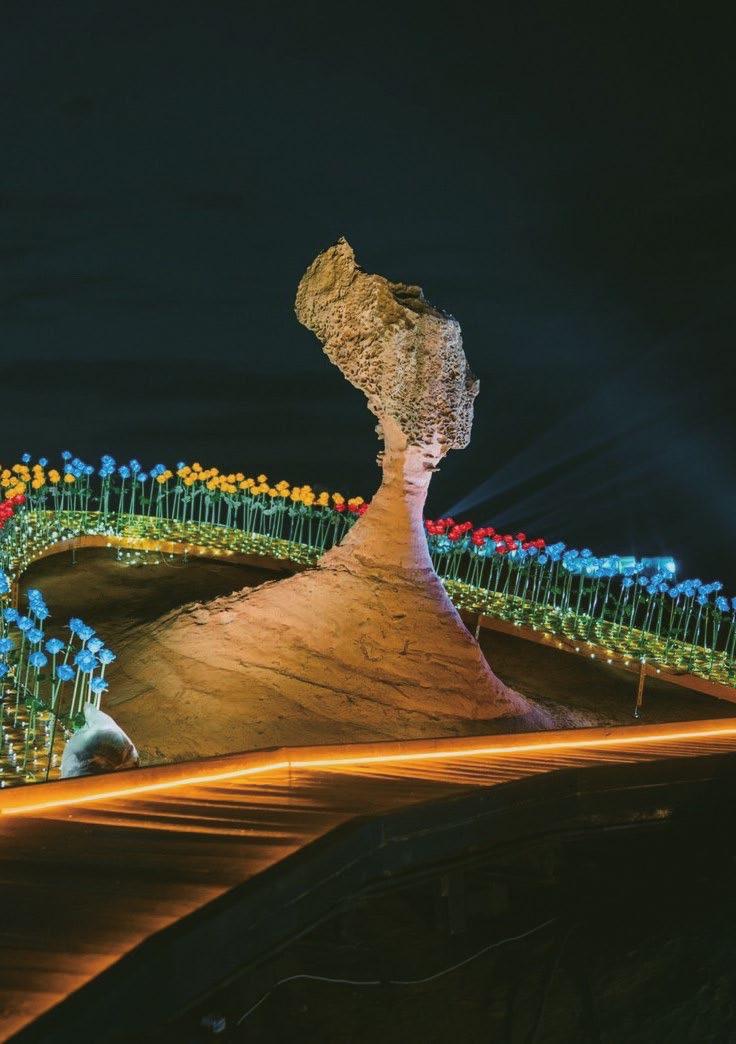


Early-Summer Fun Exciting Happenings and Events Around Taiwan
NEW TAIPEI CITY 1
June 28 ~ July 14
YEHLIU STONE AND LIGHT – VISITING
THE QUEEN AT NIGHT
野柳石光-夜訪女王
One of the most popular tourist sites in northern Taiwan, Yehliu Geopark is busy most days of the year, attracting visitors with its unique out-of-thisworld landscape featuring artistically weathersculpted sandstone rocks. During this summer event, those who stay in the park past sundown will be able to see the rocks in a much different light. Illuminated colorfully by strategically placed static lights and a fancy laser show (accompanied by music), the park is transformed into somewhat of a futuristic fairytale world. In addition to the rocks, there are also a great number of lightart installations as well as a stage presenting a scheduled water fountain and light projection show. www.northguan-nsa.gov.tw
TAITUNG COUNTY 2
June 21 ~ Sep. 20
TAIWAN EAST COAST LAND ARTS FESTIVAL & MOONLIGHT SEA CONCERT
東海岸大地藝術節暨月光・海音樂會
This festival combines the beauty of Taiwan’s East Coast region with the beauty of outdoor installation art and music. Each year, the organizer invites artists from Taiwan and abroad to create installation artworks that blend nicely with the natural environment of the East Coast National Scenic Area. A central element of the festival is the romantic Moonlight Sea Concert series, featuring well-known musicians from around Taiwan. As the concerts are timed to coincide with days around the full moon, spectators can (weather permitting) view the moonrise and the moonlight reflection on the waters of the Pacific Ocean while listening to the music. www.teclandart.tw
YILAN COUNTY 3
July 1 ~ August 13
YILAN INTERNATIONAL CHILDREN'S FOLKLORE & FOLKGAMES FESTIVAL 宜蘭國際童玩藝術節
Each year, when the summer gets intensely hot, this festival helps everyone, especially children, to cool down and have fun in a large pool-facility area. The event, which takes place in Yilan County’s Dongshan Township, provides more than just cool refreshing water, water slides, and water cannon to play with. It is an international happening with many exciting stage performances by troupes from Taiwan and abroad presenting entertaining and educational shows. There is also a wide range of classes and DIY sessions available, giving children myriad opportunities to gain knowledge. Side activities include zip-lining as well as dragon-boat paddling, sailing, and kayaking on the Dongshan River, adjacent to the festival venue. In the evening you can watch a mesmerizing water and light show.
www.yicfff.tw
©North Coast & Guanyinshan NSA Admin.
4 TRAVEL IN TAIWAN MAY/JUN 2024
©Yilan County Govt.
May~July TAIWAN TOURISM EVENTS 1 2 3
TAITUNG COUNTY
July 6 ~ August 19
TAIWAN INTERNATIONAL BALLOON FESTIVAL 臺灣國際熱氣球嘉年華
This is one of the biggest and best tourism events during the summer months in Taiwan, and one of the top hot-air balloon festivals worldwide. The venue is the Luye Highland in Taitung County, about 20km north of Taitung City, a site with perfect conditions for air sports such as paragliding. The festival not only attracts tourists in large numbers but also hot-air balloon pilots from abroad, who bring balloons of intriguing shapes and colors with them. For those who want to experience the sensation of slowly rising into the sky, there are both tethered flights and free flights available. An especially attractive element of the festival is the Night Glow Concert series (7 concerts in Luye, 5 in other Taitung locations), during which hot-air balloons are colorfully presented close together, accompanied by music and dance performances and a cool drone light show in the night sky. balloontaiwan.taitung.gov.tw
CHANGHUA COUNTY 5
June 10
LUKANG DRAGON BOAT FESTIVAL
鹿港慶端陽系列活動
One of the big three annual traditional festivals in Taiwan, the Dragon Boat Festival is best known for dragon-boat races. These are staged on rivers and lakes in more than a dozen locations around the island, including Taipei’s Keelung River and Kaohsiung’s Love River. In recent years the competition at Lukang, which takes place on the Fulu River, has emerged as perhaps the most attractive dragon-boat race event. Making it special is the fact that the races take place in the late afternoon and evening with boats, bridges, and riverbanks colorfully illuminated. Many of the town’s streets are also lavishly decorated for the occasion. Lukang is a history-rich old settlement, once a thriving saltwater port, that is great for nostalgia trips for those who want to experience the Taiwan of yesteryear. tourism.chcg.gov.tw


TAIPEI CITY 6
June 20 ~ July 6
TAIPEI FILM FESTIVAL 台北電影節
The Taipei Film Festival is an important event during which outstanding works of cinematography are awarded (Taipei Film Awards) and the works of up-and-coming local and international filmmakers are showcased (International New Talent Competition). There are numerous side events as well, including a festival preparatory school, summer surprise market, festival focus discussions, and a “Film Buff Club” that enables film fans to get close to creators and better understand the context of creation. www.taipeiff.taipei

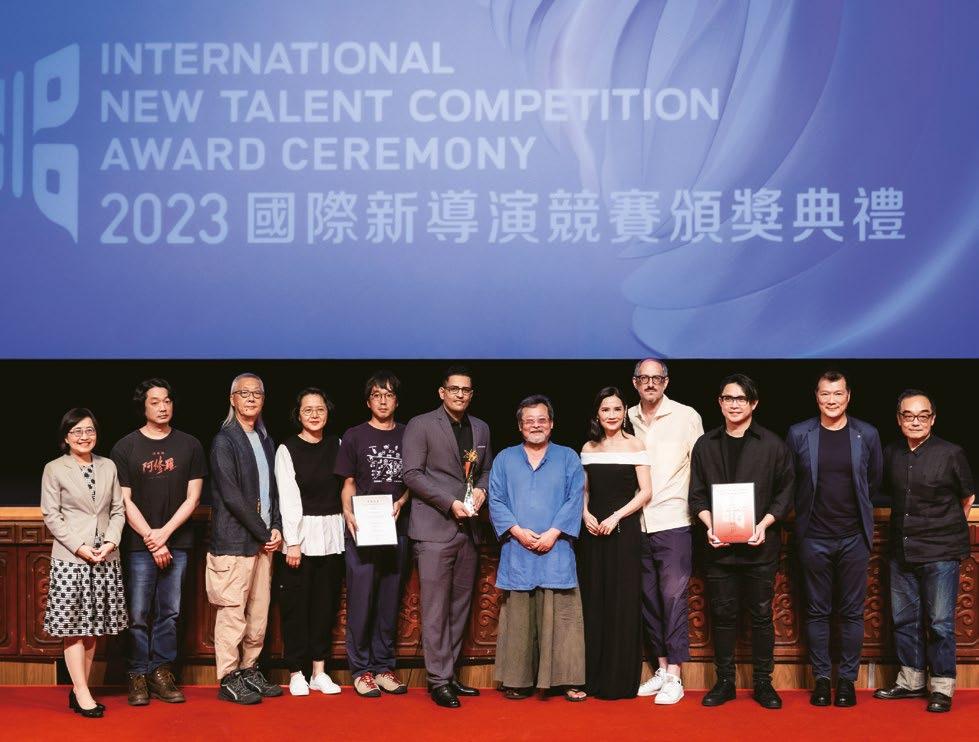 ©Taitung County Govt.
©Changhua County Govt.
©Taitung County Govt.
©Changhua County Govt.
5 TRAVEL IN TAIWAN MAY/JUN 2024
©Taipei Film Festival
4 4 6 5
Happening in TA WAN Now

Alishan Forest Railway
Railway lovers visiting Taiwan will certainly want to take a ride on the narrow-gauge Alishan Forest Railway. The construction of this railway line (total length 71.6km) began in 1902 during the Japanese colonial era (1895~1945), with operation starting in 1912 (Chiayi-Erwanping section; further sections were added in the following years). Originally used for transporting timber, with passengers also carried, the railway became a tourist operation in 1963 and has been a popular means of transport for travelers ever since. What makes the train ride special is the climb from the coastal plains (Chiayi Station; 30m above sea level) all the way up to Taiwan’s high mountains (Zhushan Station; 2,451m), traversing several climatic zones with diverse natural environments (note: the section between Shizilu and Alishan stations has been closed for repair work for many years, but is expected to be reopened this July). For those railway aficionados who can’t make the trip up to Alishan, there is another railway treat to be had in Chiayi City. On the first Saturday of each month, a coalfired locomotive (the No. 21) runs five times between Chiayi and Beimen stations, giving you the chance to go for a ride on a real steam locomotive train and snap memorable photos. afrch.forest.gov.tw

Free YouBike Rides in Taipei
Good news for visitors to Taipei who wish to explore the city on two wheels. When renting a bike of the popular YouBike public bike-rental system, the first half hour is free of cost again! Started on a trial basis in 2009 in Taipei City’s Xinyi District with just 11 stations and 500 bikes, the system has grown massively over the past 15 years. In the city alone there are now 1,345 stations (more than 6,500 in all of Taiwan). When the system was introduced the first half hour of a bike rental was free, to encourage people to try the new service; this policy lasted until 2015. The municipal government has now decided to bring free rides back to help achieve the city’s goal of reducing carbon emissions by 40 percent by 2030. The expected increase in demand for bikes will be met by adding more stations (2,000 by the year 2026) and bikes (from 16,562 to 27,500). www.youbike.com.tw

Qingshui Geothermal Education Center in Yilan
Located in Yilan County’s Datong Township on the left bank of the Qingshui River (a tributary of the Lanyang River), the Qingshui Geothermal Park is a popular day-trip destination in this part of Taiwan. After an experimental geothermal power plant was established there in 1977, local residents and then tourists started to visit the site and make use of nearby hot-water pools (up to 95 degrees Celsius) close to the river for cooking eggs and vegetables and soaking their feet. To make a visit to the site safer, the government created the Qingshui Geothermal Park in 2010, the facilities of which have been upgraded and expanded several times in recent years (including the addition of foot-soak pools, cooking pools, and a bathhouse). The latest addition is the Qingshui Geothermal Education Center (opened this January), which includes a geothermal exploration hall and a generator control room. The small center allows visitors to learn about geothermal power generation, including introductions to related machinery and local geology.
www.e-land.gov.tw

Keelung Lighthouse
Earlier this year, the Keelung Lighthouse became the 22nd lighthouse in Taiwan to be opened for visitors. Taiwan has a total of 36 lighthouses, 19 on the main island and 17 on offshore islands. The Keelung Lighthouse, located west of the entrance to the Port of Keelung on Taiwan’s Northeast Coast, was built in 1962 and has a height of 11 meters. At the site, you’ll find bilingual information boards introducing you to the tower’s history, and you’ll enjoy great views over the port’s mouth, Keelung Islet to the northeast, and Baimiweng Fort to the west (the fort is easily reached from the lighthouse by a hiking trail via Baimiweng Peak). To get to the lighthouse, take Keelung bus No. 301 from Keelung Railway Station to the Taibai Village bus stop and walk uphill from there. www.klcg.gov.tw/en
©Forestry and Nature Conservation Agency
©Yilan County Govt.
6 TRAVEL IN TAIWAN MAY/JUN 2024 TRAVEL NEWS
©Ministry of Transportation and Communications
Come!BikeDay 2024 Sun Moon Lake Cycling, Music & Fireworks Festival
Sun Moon Lake in central Taiwan’s Nantou County is worth visiting throughout the year. Indeed, it is a tourist destination you want to experience at different times of the year to fully appreciate enchanting views that can differ widely depending on weather and season.
If, however, you have just one opportunity to make it to the lake, try to schedule your trip for the fall, when the annual Sun Moon Lake Cycling, Music & Fireworks Festival takes place (October 4 to November 23 this year). The weather at this time of the year is usually the most pleasant, and during the two-month festival period there will be numerous entertaining highlight events, including live concerts, fireworks, and leisure/sports activities.
Among the festival’s regular events are (in no particular order; this year’s dates were not yet available yet at the time of writing):
• Sun Moon Lake Wedding (group wedding ceremony held at Xiangshan Visitor Center)
• Come!BikeDay Cycling Event Series – Bicycle Theme Day (leisure bike ride around the lake starting and ending at Xiangshan Visitor Center; full distance around the lake 30km; half distance, from Xiangshan Visitor Center to Ita Thao village and back, 15km)
• Sun Moon Lake Fireworks Shows and Music Concerts (three separate events, held on different days)
1. Taiwan Mobile Concert at Shuishe Wharf (well-known Taiwan pop stars perform on a large stage accompanied by a philharmonic orchestra + 8min fireworks show)
2. Music & Dance at Sun Moon Lake Concert at Ita Thao Wharf (indigenous music and dance show on small stage + 6min fireworks show)
3. NTSO Wind Ensemble Hanabi Concert at Xiangshan Visitor Center (famous film scores as well as classical and pop music presented by the National Taiwan Symphony Orchestra + 5min fireworks show)
• Sun Moon Lake Marathon (42k, 29k, and 6k runs; full marathon around the lake, starting and ending at Xiangshan Visitor Center; total number of participants limited to 5,000; registration until May 31 at runner. Fiji.co/sunmoonlakemarathon2024 )
• Sun Moon Lake Black Tea Culture Festival (tea farmers’ market at Xiangshan Visitor Center; introduction to black tea + tearolling and flower tea DIY experiences)
For more information about Sun Moon Lake and the festival, visit www.sunmoonlake.gov.tw

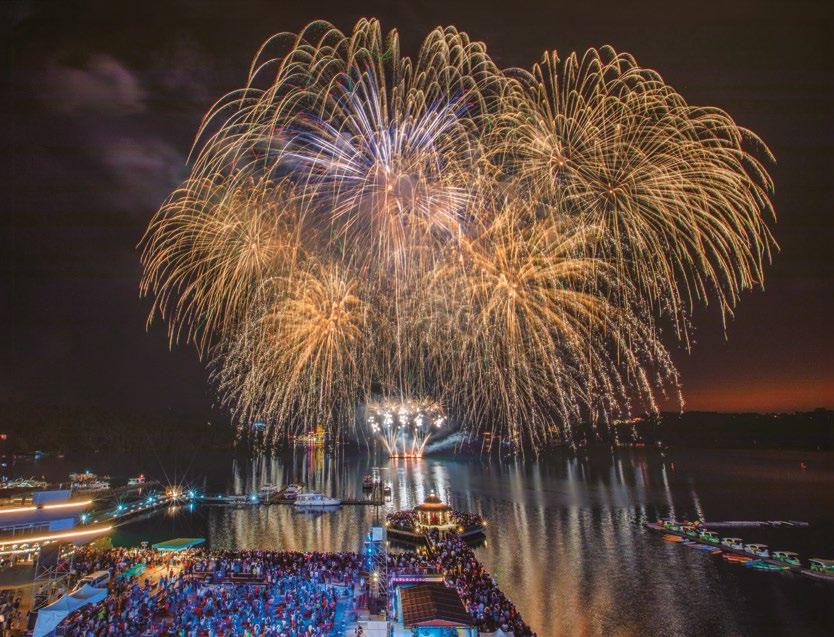

ENGLISH AND CHINESE
Come!BikeDay Cycling Event Series – Bicycle Theme Day
Come!BikeDay 自行車系列活動 - 自行車主題日
Ita Thao (Wharf) 伊達邵 ( 碼頭 )
Music & Dance at Sun Moon Lake Concert 樂舞映明潭音樂會
NTSO Wind Ensemble Hanabi Concert NTSO 台灣管樂團花火音樂會
Shuishe (Wharf) 水社 ( 碼頭 )
Sun Moon Lake 日月潭
Sun Moon Lake Cycling, Music & Fireworks Festival
日月潭花火音樂嘉年華
Sun Moon Lake Marathon 日月潭環湖馬拉松
Sun Moon Lake Black Tea Culture Festival 日月潭紅茶文化季
Sun Moon Lake Wedding 日月潭婚禮
Taiwan Mobile Concert 台灣大哥大日月潭花火音樂會
Xiangshan Visitor Center 向山遊客中心
7 TRAVEL IN TAIWAN MAY/JUN 2024 FESTIVAL
Photos © Sun Moon Lake NSA Admin.
Culture & Art
Editor's Choice


Concerts, Theater, Exhibitions, Festivals, Shows

1
Dance
FIREBIRD & RITE OF SPRING 火鳥.春之祭─異的力量
May 4 ~ 5 National Kaohsiung Center for the Arts, Weiwuying ( Kaohsiung City )
May 10 ~ 11 National Theater ( Taipei City )
Firebird and Rite of Spring are two ballet and orchestral works by Russian composer Igor Stravinsky (1882~1971). The former, written in 1910, is based on Russian fairytales of the Firebird, and the latter, written in 1913, depicts various primitive rituals celebrating the advent of spring. Choreographed by Iván Pérez, the works are performed by dancers of the Dance Theatre Heidelberg (Germany) and the Dance Forum Taipei (Taiwan), which this year celebrates its 35 th anniversary. The music is performed by the Taipei-based Evergreen Symphony Orchestra, led by acclaimed conductor Chien Wen-Pin. This production premiered on March 5, 2022 at Marguerre-Saal in Heidelberg, Germany. npac-ntch.org, www.npac-weiwuying.org
Musical 2
MISS SAIGON 西貢小姐
May 31 ~ June 2 National Kaohsiung Center for the Arts, Weiwuying ( Kaohsiung City )
June 8/9 National Taichung Theater ( Taichung City )
June 14~16 Tainan Municipal Tainan Cultural Center ( Tainan City )
June 22~30 National Theater ( Taipei City )
Miss Saigon, which premiered in London’s West End in 1989, is considered one of the four great Broadway musicals, alongside Les Miserables , Cats , and Phantom of the Opera. Staged for the first time in Taiwan this year, the musical tells the heartbreaking love story of an American GI and a Vietnamese bar girl who meet toward the end of the Vietnam War and are separated when the war ends. Though not without controversies, the musical has been a huge success because of its beautiful and moving story capturing the heartbreak of the Vietnam War and its spectacular and captivating production. www.npac-weiwuying.org, www.npac-ntt.org, www.tmcc.gov.tw, npac-ntch.org
Exhibition 3
MASTERPIECES FROM THE NATIONAL GALLERY, LONDON 從拉斐爾到梵谷:英國國家藝廊珍藏展
May 2 ~ September 1
Chimei Museum ( Tainan City )
For the first time in its 200 years, the National Gallery, London, one of the greatest art galleries in the world, is presenting an unprecedented collection of masterpieces in Taiwan! From the Renaissance master Raphael to the Dutch artist Rembrandt to the Post-Impressionist Van Gogh, some of the most precious original works by 50 masters allow visitors to experience the essence of 400 years of Western art history.
www.chimeimuseum.org
8 TRAVEL IN TAIWAN MAY/JUN 2024
1 2 3


Editor's

MORE THAN USEFUL – THE STORY OF WOOD
材不材–木的故事特展
Until November 24
National Museum of Natural Science ( Taichung City )
If you wish to understand more about wood in general, and the wood of Taiwan in particular, this exhibition will give you an excellent overview. It introduces you to the diverse forests of this island – 60% of which is tree-covered – from the coasts to the high mountains. It also explains how trees have adapted to their natural environment and the important roles wood plays in our lives. On display are dozens of Taiwanese tree specimens, including 400-year-old Taiwan spruce discs and examples of petrified wood, as well as large logs of red cypress, hinoki cypress, Taiwan incensecedar, and small-flowered camphor tree. www.nmns.edu.tw
MODERN LIFE: TAIWAN
ARCHITECTURE 1949-1983
摩登生活:臺灣建築1949–1983
Until June 30 Taipei Fine Arts Museum ( Taipei City ) Exhibition 5
This exhibition takes a fascinating look at the architecture that was prevalent in Taiwan during the three-plus decades that followed WWII and the return of the island to Chinese rule. During this time, architects were drawn to Western styles and ideas – influenced by aid received from the U.S. (1951 to 1965). At the same time, there also was a movement to develop modern Chinese architecture on one hand and a distinct local Taiwanese style on the other. The timeline of this exhibition reveals Taiwan’s gradual emergence from the shadows of political ideology towards a modern era of freedom.
www.tfam.museum
Exhibition 6
TRANSCENDING 1624: TAIWAN AND THE WORLD
跨•1624:世界島臺灣國際特展
Until June 30
National Museum of Taiwan History ( Tainan City )
The year 1624 was important in Taiwan’s history because it saw the arrival of the Dutch and the start of their colonial rule (1624~1662) in the southwestern region (today’s Tainan) and other, mostly coastal, parts of the island. A few years later the Spanish would follow, controlling parts of the north (1626~1642). For Taiwan, this meant coming in direct contact with European seafaring nations, which led to significant trade and cultural exchange. This exhibition explores Taiwan’s arrival on the world stage and also sheds light on the general history of trade and Western influence in East Asia during the 17th century (including Portuguese trade relations with Japan), presenting historic documents and maps, models of ships, old weapons, paintings, and much more.
www.nmth.gov.tw (Chinese)
9 TRAVEL IN TAIWAN MAY/JUN 2024
Exhibition 4
Choice 5 6 4

Mt. Jade (Yushan) has beckoned many an intrepid adventurer to climb towards the heavens, but the island’s highest peak is far from the only reason to visit southern Nantou County in central Taiwan. Contained within the following pages, you’ll find blooming blossoms, big bridges, beautiful birds, balmy bathing, and other delights without neatly alliterative names.
Gateway to the Sky
Exploring the Southernmost Reaches of Nantou County’s Xinyi Township
NANTOU Highway 21 & Mt. Jade 10 TRAVEL IN TAIWAN MAY/JUN 2024
TEXT AMI BARNES PHOTOS RAY CHANG, VISION
NANTOU Highway 21 & Mt. Jade

Mountainous and sparsely populated, Nantou County’s Xinyi Township borders Chiayi County and Kaohsiung City to the south and Hualien County to the east. Vast tracts of its eastern landmass are protected wilderness areas threaded with challenging overnight treks, making it a much-loved destination among outdoor enthusiasts. The region is also home to members of the indigenous Bunun tribe, but the majority of the population – Bunun or otherwise – lives in a scattering of settlements clustered along Provincial Highway 21 in its western area. Many residents here are engaged in the production of tea, grapes, or plums, with agritourism forming a significant pillar of the region’s leisure industry. Whether you’re seeking high-elevation adventures or a quiet day on the farm, Xinyi Township is calling.
Mt. Jade in Yushan National Park
11 TRAVEL IN TAIWAN MAY/JUN 2024

Yushan National Park
Reaching 3,952m above sea level, the summit of Mt. Jade is the highest point in Taiwan – the literal and metaphorical pinnacle of many a Taiwanese bucket list. The traditional twoday route, while easy by Taiwan mountaineering standards, calls for an overnight stay at Paiyun Lodge, not to mention the forethought and luck required to secure one of the coveted limited-number permits. If that sounds like a bit too much fuss, do not fret, Yushan National Park has a great alternative trail that can be done with minimal pain.
Before embarking on a description of this route and its attractions, it is worth pointing out that even for a casual day hike, preparation is essential. Once you arrive at Shangdongpu Car Park , close to the trailhead, there are no places to purchase provisions, so bring snacks and a water bottle (water dispensers are available at Paiyun Hiking Service Center and Lulin Cottage, both introduced momentarily).
Weather is another important variable. For every 100m of elevation ascended, there is a 0.6 degree Celsius drop, so expect temperatures significantly cooler than at lower reaches, but be prepared for changeable conditions. I’ve visited this part of the park twice, once on a cool and rainy July day, when coats were very much required, and once in early February

 Paiyun Hiking Service Center
Lichen on pine tree
Paiyun Hiking Service Center
Lichen on pine tree
12 TRAVEL IN TAIWAN MAY/JUN 2024
Giant Taiwan Hemlock
(for this article) with bright sun that would have made it comfortable to wear a T-shirt. Speaking of sun, the effects of UV rays are experienced more acutely the higher up you go, and with parts of this trail being entirely exposed, sunscreen and a hat are a must. Finally, note that our hike begins at around 2,500m above sea level – the elevation that is generally considered to be when people first experience high-altitude illness, so be alert to the risks.
There are several interlinking trails just to the east of Highway 18 (Highway 21 ends and becomes the 18 at Tataka Visitor Center, a little to the north). From the Shangdongpu Car Park, hikers first follow asphalt-topped Nanxi Forestry Road to the Paiyun Hiking Service Center, where you have to report if you are hiking to the peaks of Mt. Jade and beyond; no mountain permits are needed for the trails introduced in this article. After a 30min uphill stroll, you will find yourself standing in the shadow of the Giant Taiwan Hemlock . This 600-year-old park parishioner guards the junction of Nanxi Forestry Road and Yushan Forestry Road, its sprawling boughs clad in green penny ferns and draped with tendrils of lichen. You can take either road for the loop
NANTOU
route that includes Mt. Lulin and Mt. Linzhi, but turning right onto Yushan Forestry Road offers a marginally easier hike.
After turning right at the junction, walkers follow a gently ascending road padded with mounds of pine duff to reach the next point of interest, Lulin Lodge . This lodge was built in 1934 using Formosan cypress trees felled in the Alishan area to the west (which Highway 18 goes through). In the old days, this was the place where hikers stayed before taking on the final ascent of Mt. Jade. These days, only workers of the Forestry and Nature Conservation Agency (Forestry Bureau until 2023) have the privilege of staying here, while most aspiring summiteers bunk at Dongpu Lodge close to the Shangdongpu Car Park.
Moving onwards, you will soon reach the start of the proper trail. This is the last stop with a water dispenser and bathroom facilities, so it’s the perfect spot to pause for a while. From here, it’s a steep and steady 30min climb up steps lined with pine trees and arrow bamboo to the vistaless summit of Mt. Lulin (2,845m). The steps are steep, but whether lit with tree-filtered sunlight or shrouded in fog, the trail’s beauty is almost enough to make you forget the heaviness of your legs.
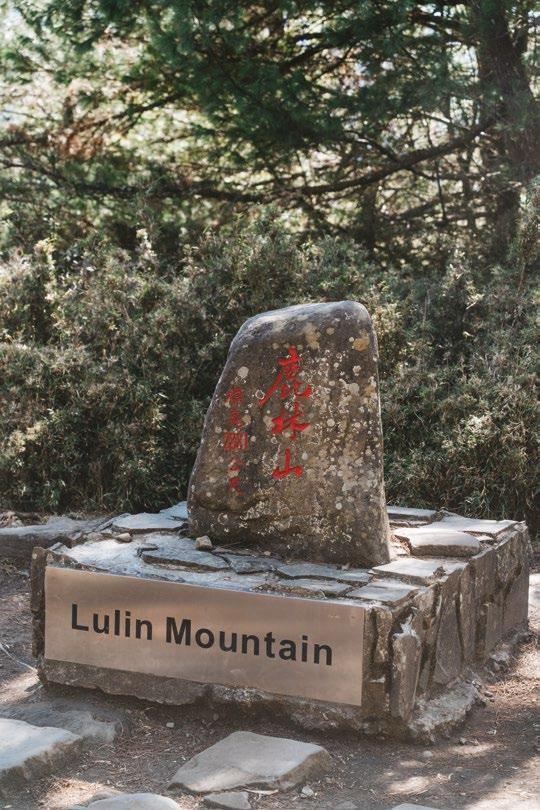
 Trail between Mt. Lulin and Mt. Linzhi
Trail between Mt. Lulin and Mt. Linzhi
13 TRAVEL IN TAIWAN MAY/JUN 2024
Mt. Lulin marker
Highway 21 & Mt. Jade

Where the trail from Paiyun Hiking Service Center to Mt. Lulin offers some wonderful walking through forest, the path leading onwards to Mt. Linzhi is a non-stop parade of scenic outlooks – at least in clear weather. On our Travel in Taiwan research trip for this article, we were welcomed by glorious sharpcut sunlight picking out distant crags and crevices in high contrast, but on my earlier trip, a mud-to-heavens wall of not-quite-white fuzzed the edges of trees even five meters away. (You take the beauty you get on the day – such are the mercurial whims of high-mountain weather.)
The well-marked trail cuts a meandering route down towards the Mt. Linzhi Saddle . Along the way, the most conspicuous flora species encountered are Taiwan red pines and Armand pines –the two easily distinguished by their differing cones, with the Armand cones being larger and more elongated in contrast to the rounder, stubbier cones of the Taiwan red pine. Depending on the season, you may also spot oxeye daisies, tall foxgloves in shades of pink and white, or the spiky-leafed and amethyst-hued Yushan thistle.

NANTOU Highway 21 & Mt. Jade 14 TRAVEL IN TAIWAN MAY/JUN 2024
Steep descent from Mt. Linzhi (Mt. Jade Front Peak in the background)


It’s not just botanists who will have lots to see. Birdwatchers and wildlife fans stand a reasonable chance of some close encounters with the local fauna. Sightings of the Eurasian nutcracker and the Taiwan-endemic whitewhiskered laughingthrush are all but guaranteed. The former is chocolatey brown and black with a white speckled hood and crow-like caw, while the latter is identifiable by its yellow wing bars, white facial stripes, and brazen, inquisitive nature.
Muntjacs and Formosan rock macaques are also commonly sighted, while other species, including the Taiwan serow, yellow-throated marten, Formosan sambar deer, and Mikado pheasant may appear if you have luck on your side. On this most recent visit, my wildlife highlight was a flamecrest, a tiny endemic bird, the males of which sport the most adorable firey mohawks. And even if the creatures are being reticent, you can still divine traces of them in the landscape. Their prints stud the muddy bottoms of trailside alpine pools, and piles of poop dot the meadows – size is the key to identification, muntjac droppings are tic tacesque, while sambar deer droppings are the size of a jumbo chocolate-coated peanut, and serow poop is somewhere between the two.
Of course, wildlife sightings are indisputably exciting, but the primary draw of the trail to Mt. Linzhi (2,854m) is its spectacular scenery. Whichever way you look, there are layers upon layers of peaks in view. In clear sunny


weather, nearer slopes are painted green with the occasional patch of exposed rock, and distant peaks take on a bluish haze-filtered tint. For much of the walk, the towering rocky main summit of Mt. Jade dominates the eastward vistas. On our visit, its face was ribboned with a latticework of white following a dusting of snow a week earlier. In addition to Mt. Jade’s various peaks, several other of Taiwan’s highest mountains are huddled among the summits grazing the skyline.
The descent from Mt. Linzhi is by far the steepest part of the day’s walk, and a test for tired thighs. The steps run down to rejoin Nanxi Forestry Road at the Yushan Trailhead (2,600m). There, you can hop on one of the shuttle bus services (NT$100 per passenger) and be swiftly returned to Shangdongpu Car Park.
Flora
Armand pine 華山松
foxglove 毛地黃
oxeye daisy 法國菊
Taiwan red pine 台灣二葉松
Yushan thistle 玉山薊
Fauna
Eurasian nutcracker 星鴉
flamecrest 火冠戴菊鳥
Formosan rock macaque 台灣獼猴
Formosan sambar deer 台灣水鹿
Mikado pheasant 帝雉
muntjac 麂
Swinhoe's pheasant 藍腹鷳
Taiwan serow 台灣長鬃山羊
white-whiskered laughingthrush 金翼白眉
yellow-throated marten 黃喉貂
Mt. Linzhi Saddle
Formosan rock macaque Mikado pheasant
Flamecrest (©Yushan National Park)
15 TRAVEL IN TAIWAN MAY/JUN 2024
NANTOU Highway 21 & Mt. Jade
Sights Along Highways 21/18
Anyone wishing to hike the trail detailed in the previous pages has two ways of arriving at the trailhead – either by following Provincial Highway 21 south from the town of Shuili or Provincial Highway 18 eastwards from the Alishan area. For those approaching from Shuili, the road sticks close to the Chenyoulan River as it passes through a string of agricultural settlements with both Mandarin and Bunun names. Vineyards, plum orchards, and cozy B&Bs are the most significant sources of income for residents in this region. Unfortunately, we visited three months before the spring plum harvest and about six months too early to enjoy the summer’s sun-sweetened glut of plump kyoho grapes.

The village of Heshe is the last pit stop with a convenience store before the waterway cleaves in two. The Chenyoulan River narrows as it approaches Dongpu village, while Highway 21 follows the Heshe River for a short distance before doubling back to climb up to the Caopingtou Yushan Tourist Tea Garden. From this point on – where there are yellow gates that are shut between 5:30pm and 7am to prevent traffic from entering the national park at night – the highway begins to ratchet things up a gear as it snakes its way through ever wilder terrain. Visible on your left-hand side as you pass kilometer marker 119, an Yushan National Park boundary marker announces
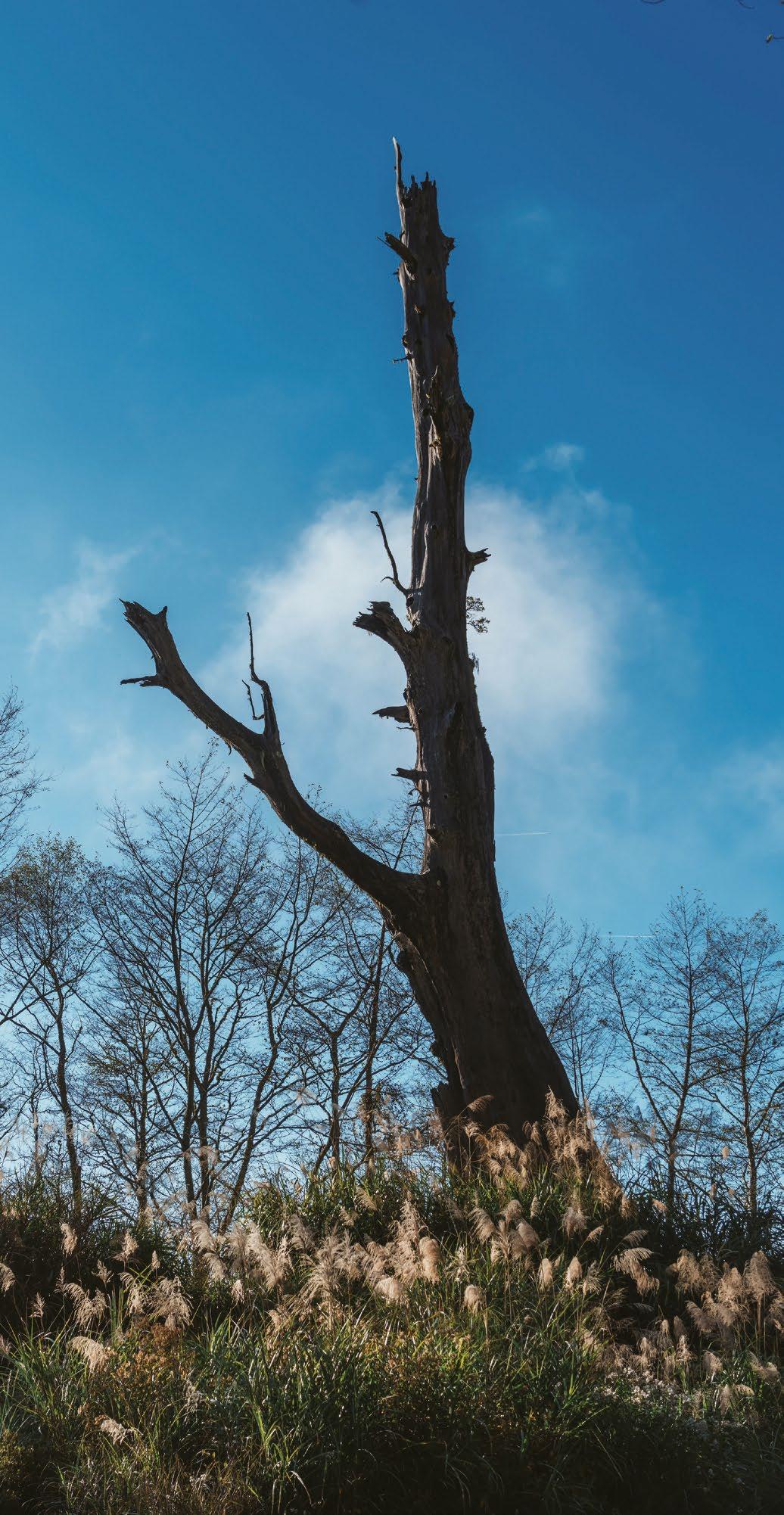
your arrival into parkland, and five minutes later a pull-off spot offers a chance to stretch your legs and get an initial glimpse of Mt. Jade.
Wildlife sightings are common along this road, as evidenced by the many warning signs urging drivers to slow for furred and feathered friends. Our journey was brightened with the spotting of a Swinhoe’s pheasant and a monkey or two. A little further up, we saw a male Mikado pheasant – of NT$1,000note fame – as we pulled into a parking lot beside the Tataka Husband and Wife Divine Trees site, where only the heartbroken and sunbleached skeleton of the wife tree remains standing. Before the husband tree
Majestic Mt. Jade seen from Highway 18
NANTOU Highway 21 & Mt. Jade 16 TRAVEL IN TAIWAN MAY/JUN 2024
Wife Tree

fell (June 30, 2017), their interlocking branches gave the appearance of coupledom. This cute anthropomorphic description appeals to many, but an indigenous story offers an alternative version. According to that telling, the trees contained the spirits of a pair of ne’er-do-well magicians, eternally imprisoned within as castigation for disturbing the peace. Despite their captivity, the duo were still accused of affecting traffic in the vicinity, for which the 1996 lightning strike that cut off their entwined limbs was punishment.
Driving a further 10min uphill will bring you to the Tataka Visitor Center, which is a great place to stop if you’re interested in learning more about Yushan National Park. Bilingual displays cover topics including the history of mountaineering in the area as well as local indigenous culture, geology, and ecology, and the center is also home to the only restaurant for miles around.
Our hike to Mt. Lulin and Mt. Linzhi started just a kilometer southwest of the Tataka Visitor Center at Shangdongpu Car Park. Continuing westwards on Highway 18 from there will soon bring you to the second boundary monument, marking your exit from the national park. Not far beyond this is the Lulin Divine Tree . While somewhat visible from the road, the true scale of this millennia-old Formosan cypress doesn’t become apparent until you’ve descended zigzagging steps and stand at its base. At 43m, it’s not the tallest tree in Taiwan – not even close – but it is believed to have the second-largest circumference. Record-breaking or not, there’s little more awe-inspiring than being in the presence of an entity that has seen a hundred human generations live and die.
Lulin Divine Tree
As mentioned in passing above, Caopingtou Yushan Tourist Tea Garden is a pleasant stopping point on Highway 21. Known for the 4,000-odd fruit trees that brighten the slopes, blossom season sees it transform from a peaceful tea-growing community to a floral fiesta. It gets so busy, in fact, that a parkand-ride system has been established to deal with all of the tour buses, and cars are siphoned off onto a side road to purchase tickets (NT$50 per person, and another NT$100 for parking).
I have seen my fair share of blossom hotspots, so I was prepared to be underwhelmed, but the sheer volume of the blossoms at Caopingtou was incredible. We visited in the early days of February, so the plum blossom was the undisputed star of the show. Ramrod-straight branches shot up as thick and fluffy as an undocked lamb’s tail. Gazing up at the perfect combination of white petals against a clear blue sky,


I enjoyed watching the honeybees half clambering, half flying from blossom to blossom, hind legs laden with golden pollen, and wings lazy from abundance.
Later in the season, cherry trees take center stage. Even in early February, however, the early-blooming Taiwan mountain cherry trees were already adding patches of hot fuschia to the landscape. Throughout February and March, first Fuji, then Yoshino, and then double-layered
varieties take turns to paint the hills. Each variety is beautiful in a different way – the blossom of the Yoshino cherry is large-petaled and elegant, Fuji cherries have the most exquisite color palette of pinkish-white petals converging around dusty-pink stamen with chartreuse leaves, and the late blooming double-layered cherries seem to be determined to end the season with a bang by producing so many petals that they resemble miniature tree-borne carnations.

Sakura tourism is the number one activity at Caopingtou, but it is not the only draw. Visitors also head here to enjoy the aesthetically pleasing contrast of neatly lined tea plantations against a backdrop of high-mountain scenery. Farmers take advantage of the elevation’s cooler temperatures and year-round mists to produce Yushan Oolong – which according to connoisseurs is a delicate tea with a sweetly mellow and floral taste that is evocative of its growing environment.
Taiwan mountain cherry tree
Blooming plum trees at Caopingtou
21 & Mt. Jade 18 TRAVEL IN TAIWAN MAY/JUN 2024
NANTOU Highway
NANTOU



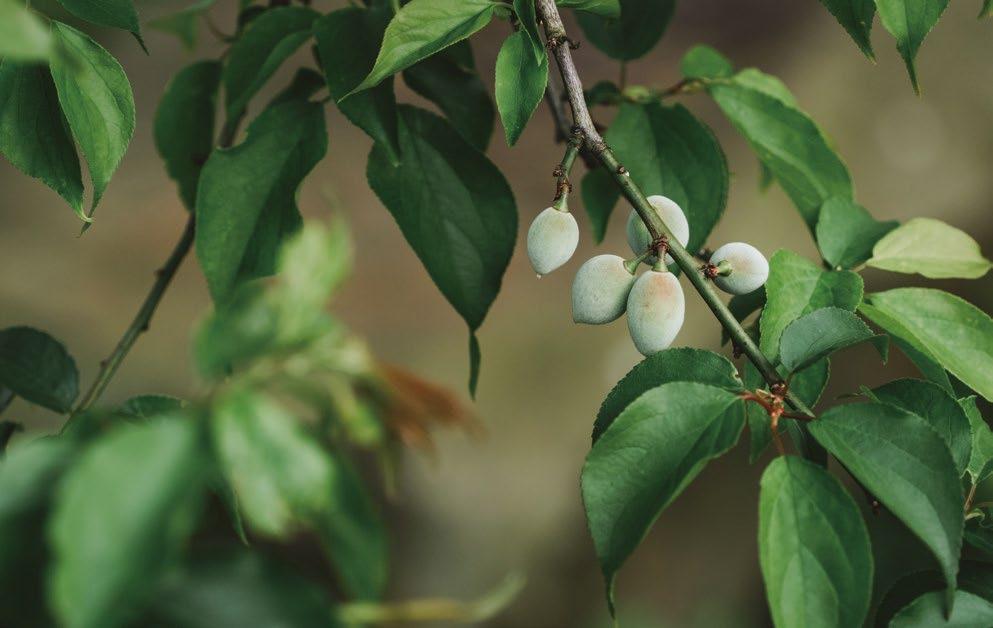
Another great place to appreciate tree blossoms in Xinyi Township is the village of Fengguidou . About halfway between Caopingtou and the town of Shuili, reached by a winding minor road on the west side of the Chenyoulan River valley, this spread-out village is said to produce around four-fifths of Taiwan’s greengage plums. The majority of the trees here are 30~40 years old, but the settlement’s celebrity is a characterful septuagenarian dubbed the Plum King, whose branches curve expressively downwards in stark contrast to its many betel-nut neighbors.
Come late December, the white-flecked canopies appear like misplaced snowdrifts in an otherwise green landscape. Such scenery is especially sought-after because it requires that the conditions be just so. Too much wind, an extreme cold snap, rain – these can all contribute to a season being a wash-out, and indeed, there was just a light dusting of petals clinging to the trees when we visited. But even if you miss out on the blossoms, Fengguidou is worth the trip. Year-round, there are enchanting views of distant mountains, and as spring arrives the focus shifts to harvesting and processing the crop. Visitors can enjoy the efforts of the farmers’ hard work by sampling plums that have been powdered, pickled, jellied, juiced, vinified, vinegared, and otherwise turned into all kinds of plummy treats.
View of the Chenyoulan River valley and the towering mountains beyond Young green plums
70-year old Plum King at Fengguidou
Highway 21 & Mt. Jade 19 TRAVEL IN TAIWAN MAY/JUN 2024

Dongpu
An overnight stay somewhere along Highway 21 is a common way to kick off or conclude a foray into the Yushan National Park mountain fastness. One commonly chosen destination is the hot-spring village of Dongpu, which can be accessed by turning onto Nantou County Road 60 at Heshe village.
Dongpu is well-known among the local hiking community as the jumping-off point for one of Taiwan’s best-loved multiday treks – the Batongguan Traversing Trail . First constructed in 1875 at the request of Qing officials, it was one of several cross-island routes built in the wake of the 1871 Mudan Incident – a watershed moment in Taiwan’s history – with the intent of quelling restive indigenous communities. That trail quickly fell out of use, only to be rebuilt around 1920


by Japanese colonial authorities following a similar route and with similar animus. The entire journey, which cuts southeast from Dongpu as it makes its way over the county border into Hualien, takes eight days to complete and requires hikers to apply for permits and carry tents. The first four kilometers from Dongpu, however, can and should be done by almost anyone who loves hiking. The path climbs gradually upwards along mostly well-kept paths to Yunlong Waterfall , and in terms of the ratio of views enjoyed to the effort expended, this walk is hard to beat. That said, the trail is not entirely dangerfree – walkers are required to exercise caution while crossing sections that have been wiped out by landslides.
Hot-spring village Dongpu (©Yushan National Park)
Batongguan Traversing Trail (©Yushan National Park)
20 TRAVEL IN TAIWAN MAY/JUN 2024
Dongpu Suspension Bridge
If you’re feeling the need for something less strenuous, you might want to enjoy the trail vicariously by reading about its history at the Dongpu Service Center – which is also where hikers setting off to complete the full route need to register. Another gentle adventure awaits in the form of the Dongpu Suspension Bridge. When it opened in 2005, this 128m-high, 200m-long span was the highest bridge in Taiwan. A pair of wild-boar sculptures sits at the northern entrance to the bridge, sly smiles suggesting they’ve seen many a boastful tourist defeated by the vertiginous drop visible through the bridge’s metal grillwork. Those bold enough to step foot onto the bridge will have their bravery rewarded with cinematic valley views.
As the evening draws in, what better way to soothe those travel-weary muscles than with a dip in a hot-spring bath? Dongpu’s thermal waters are clear and odorless, and their restorative properties have attracted bathers for a century or more. Like many hot-spring destinations, a small industry has grown to cater to out-of-towners, so you can now choose from a dozen or so hot-spring operations with a genteel, Japanese kind of aesthetic. And with many of the hotels allowing guests to pay an NT$250~300 fee to use their spring facilities, even travelers on a budget get to end their day with a satisfying soak.
ENGLISH AND CHINESE
Alishan 阿里山
Batongguan Traversing Trail 八通關越嶺古道
Bunun tribe 布農族
Caopingtou Yushan Tourist Tea Garden 草坪頭玉山觀光茶園
Chenyoulan River 陳有蘭溪
Dongpu 東埔
Dongpu Lodge 東埔山莊
Dongpu Service Center 東埔服務中心
Dongpu Suspension Bridge 東埔吊橋
Fengguidou 風櫃斗
Giant Taiwan Hemlock 大鐵杉
Heshe (River) 和社 ( 溪 )
kyoho grapes 巨峰葡萄
Lulin Divine Tree 鹿林神木
Lulin Lodge 鹿林山莊
Mt. Jade (Yushan) 玉山
Mt. Linzhi (Saddle) 麟趾山 ( 鞍部 )
Mt. Lulin 鹿林山
Mudan Incident 八瑤灣事件
Nanxi Forestry Road 楠溪林道
Paiyun Hiking Service Center 排雲登山服務中心
Paiyun Lodge 排雲山莊
Plum King 梅王
Shangdongpu Car Park 上東埔停車場
Shuili 水里
Tataka Husband and Wife Divine Tree 塔塔加夫妻神木
Tataka Visitor Center 塔塔加遊客中心
Xinyi Township 信義鄉
Yunlong Waterfall 雲龍瀑布
Yushan Forestry Road 玉山林道
Yushan National Park 玉山國家公園
Yushan Oolong 玉山烏龍茶
Yushan Trailhead 玉山登山口

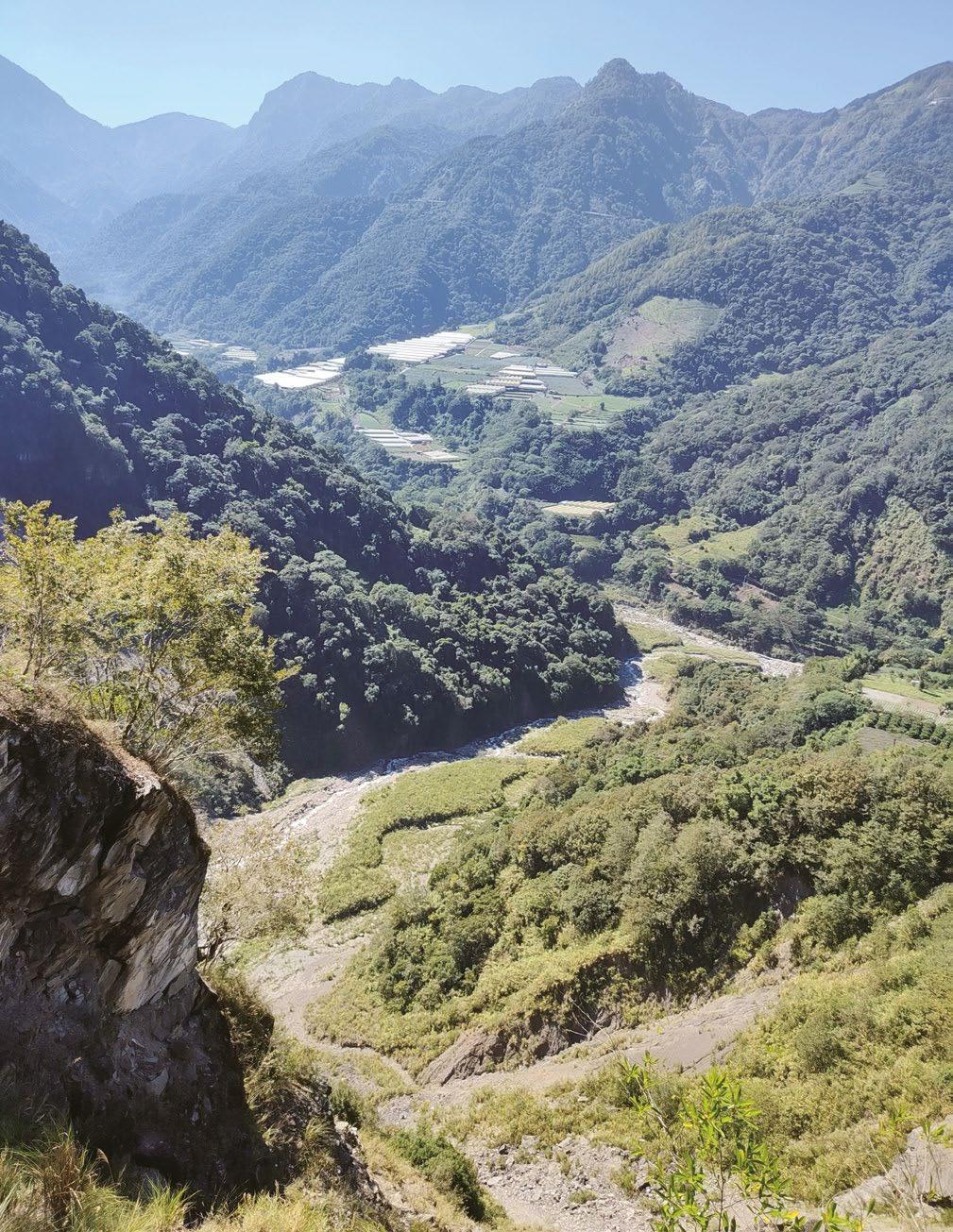

MAP
View from Batongguan Traversing Trail (©Yushan National Park)
Highway 21 & Mt. Jade 21 TRAVEL IN TAIWAN MAY/JUN 2024
Yunlong Waterfall (©Yushan National Park)
NANTOU

MorethanJustaSunMoonLakePitStop
A short jaunt up National Freeway 6 from central Taichung, the mountain-hugged, basin-nestled town of Puli offers a satisfying mix of urban amenities, outdoor adventures, and tourist experiences to suit all tastes. In short, it has all the makings of a great base for a varied and relaxing break. TEXT
PHOTOS
NANTOU Puli
AMI BARNES
RAY CHANG, VISION
Cona's Chococastle
Acommon stopover for travelers breaking up their journey to Sun Moon Lake, this diminutive town, the urban heart of Puli Township, occupies a wedge of land covering no more than five square kilometers. Suspended in the center of a mountain-fringed depression, the hilly surrounding landscape is a constant presence. The downtown’s crowded store signage frames distant peaks, and under big skies beyond the built-up area, fields of water bamboo spill across the basin’s flat bottom as far as the terrain will allow. Many a passerby has been enticed to pause and sample Puli’s slower pace of life. Read on for a few pointers on how and where to while away a while.
Cona’s Chococastle
Cona’s Chococastle is not an easily missable building. This three-story faux castle sits just off County Highway 21 about 4.5km southwest of central Puli, enticing kids with its Disney-esque pointy turrets and chocolate promises. Tickets can be purchased at the gate (cost is partly redeemable against in-store purchases), and from there you head past a horse-drawn carriage and into the first-floor main hall. Here, visitors will find a fancydress wardrobe full of prince and princess getup – yes, adults included – that can be donned for photo shoots and to enhance the castle experience.
The second floor is given over to a café selling gelato and coffee, and there’s also an enclosed area where children can make their own DIY confectionary creations. Personally, however, I thought the most interesting area was the third-floor factory. Strawberry thins were produced the day of our Travel in Taiwan visit, and we watched molten baby-pink chocolates being molded, cooled, and zipped along mini conveyor belts before being sealed in individual packets and arranged into boxes by a robotic arm.
Returning to the ground floor, you’ll find a shop filled with colorfully packaged chocolates. Top offerings include dark chocolate thins filled with ruby sauce, matcha nama chocolate cubes, and the same strawberry thins we’d seen in production.
CONA'S CHOCOCASTLE ( 妮娜巧克力夢想城堡 )
No. 32, Taomi Rd., Taomi Borough, Puli Township, Nantou County ( 南投縣埔里鎮桃米里桃米路 32 號 ) (049) 291-9528
www.conas-choc.com
www.facebook.com/conas.castle



 Chocolate sales area on first floor
Fine-chocolate products
Chocolate DIY area
Chocolate sales area on first floor
Fine-chocolate products
Chocolate DIY area
NANTOU Puli 23 TRAVEL IN TAIWAN MAY/JUN 2024
Cacao tree outside the castle



Grandpa Lai’s Honey
A neckerchief-toting Formosan black bear welcomes visitors to Grandpa Lai’s Honey with a leading question: “You’re so sweet, aren’t you going to come in and have a little honey?” Indeed, honey is the flavor of the day (every day) at this establishment on the outskirts of Puli town. The ground-floor store has scores of different honeys and honey products on display, and visitors are welcome to sample the wares.
I have never been a big honey fan, but in the interest of thorough research, I tasted my way through the various multi- and mono-floral varieties on offer. And I’m very glad I did, because I discovered that it’s not so much that I dislike honey, but more that I just hadn’t tried the right one before. Two in particular stood out – both mono-floral varieties – one made by bees who feasted mostly on beggarticks, the second a schefflera tree honey. Both of these possess distinctive herbal hints that elevate them above the cloyingly one-note sweetness of regular honeys.
As well as selling honey, the enterprise aims to educate visitors about bees, and to that end the premises include a single-room museum full of fascinating bee facts (all in Chinese). Even without reading the exhibits, kids will enjoy the cute drawings and love watching the comings and goings in the glass-encased observation hives.

Goang Xing Paper Mill

Those without a sweet tooth may be more interested in a visit to Goang Xing Paper Mill. Approaching its 60 th year in business, the mill is a window into one of Puli’s heritage industries. In the final decade of Japanese rule (1895~1945), dozens of paper mills sprung up in the area, and at the industry’s peak in the mid-1980s around 50 mills were churning out handmade paper. Thanks to the region’s uncontaminated water – a vital element in the papermaking process – Puli became synonymous with artisanal papercrafts and high-quality papers.
As the frenetic pace of Taiwan’s economic miracle slowed, increasing mechanization, resource scarcity, and an aging workforce prompted many of Puli’s mills to throw in the (paper) towel – a fate Goang Xing evaded by pivoting into the tourism industry. Now, visitors can attend factory tours (every half hour in Chinese or by prior arrangement in English) and watch as raw materials are boiled, beaten, pulped, and pressed into sheets. The factory also offers the opportunity to get all hands-on with DIY paper-making and printing plus a variety of paper crafts.
Grandpa Lai's Honey One-room museum
Master papermaker at work
NANTOU Puli 24 TRAVEL IN TAIWAN MAY/JUN 2024
DIY paper-making area
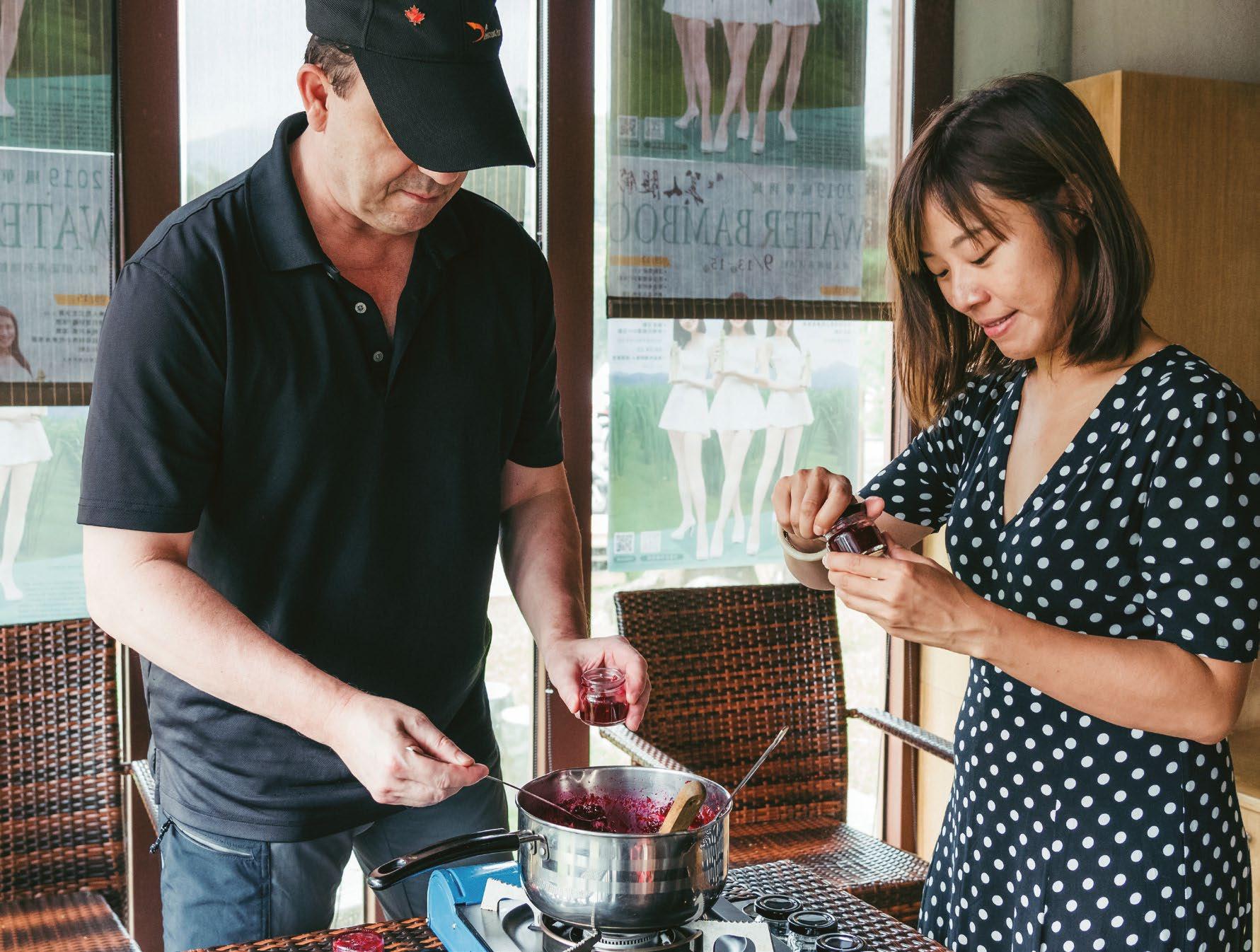
Puli Distillery
Puli Distillery sits beside small Liyu Lake, separated from the urban spread of the Puli Basin by the low rise of Hutou Hill. Despite the name, the two-story building is less a working distillery and more a combined educational and market space. The second floor is given over to a museum dedicated to the history of Puli Distillery and the distillation process, while the ground floor is occupied by a Puli Farmers’ Association marketplace where you can sample and purchase the alcohols made and some of the local specialty agri-products, including all manner of cooking condiments.
The distillery has an extensive range of award-winning alcohols to choose from, such as Yushan Ailan 16-Year Aged Liquor and a pink-tinted rosé wine. Beyond these distinguished drinks and more run-of-the-mill fare, the market area also offers some rather unique alcohol choices (medicinal black chicken wine, anyone?). And teetotalers don’t need to leave empty-handed, either. There are plenty of treats on offer, like bamboo chips and dried roselle candy.
PULI DISTILLERY ( 埔里酒莊 ) No. 22-3, Liyu Rd., Wusong Borough, Puli Township, Nantou County ( 南投縣埔里鎮蜈蚣里鯉魚路 22-3 號 ) (049) 242-3828
www.facebook.com/pulidistillery



GOANG XING PAPER MILL ( 廣興紙寮 )
No. 310, Tieshan Rd., Tieshan Borough, Puli Township, Nantou County ( 南投縣埔里鎮鐵山里鐵山路 310 號 ) (049) 291-3037
www.taiwanpaper.net (Chinese)
www.facebook.com/taiwanpaper
GRANDPA LAI'S HONEY ( 賴爺爺蜜蜂小森林 ) No. 99, Ci'en St., Pipa Borough, Puli Township, Nantou County ( 南投縣埔里鎮枇杷里慈恩街 99 號 ) (049) 298-0851
www.laishoney.com.tw
Rose jam-making DIY at the distillery Puli Distillery
Liyu Lake
NANTOU Puli 25 TRAVEL IN TAIWAN MAY/JUN 2024
Rose wine
Hui Sun Coffee Brand Store
Holidaymakers passing through Puli Township on their way to Sun Moon Lake tend to leave Freeway 6 at the Ailan Interchange before immediately taking a left onto Provincial Highway 14. Coffee fans, however, should turn right instead and make an important stop before heading onwards for a weekend of lakeside bike rides and paddleboarding on the lake.
Hui Sun Coffee sits just back from the highway. Its modern-looking exterior is matched with bright, highceilinged interiors and a flight deck of gleaming, state-ofthe-art barista tech. The staff know their stuff inside out, and on our recent visit we were treated to impassioned in-depth explanations of each item we sampled, starting with a siphon brew made with 100% Taiwan-grown beans sourced in neighboring Guoxing Township. This coffee has a complex flavor profile, with a tea-like aftertaste that fades into a lingering sweetness. Following some palettecleansing water, we tried a pour-over brew with a strident bitter-yet-fruity piquancy. Moving on, our third drink was one of the creamiest lattes I have ever tasted. It was


so perfectly frothed that the mouthfeel was closer to a warm scoop of ice cream than coffee, while the dash of caramel and drift of puffed rice took it to another level. Our final choice was a sparkling passionfruit and guava drink that is best described as the taste of childhood summers in a glass.
Hui Sun Coffee’s attention to detail isn’t limited to beverages. It also offers a store full of local products and a menu of treats – all prepared to the same exacting standards. Think pillowy breads paired with chunky fruit conserves, tarts made with fragrant Assam lemons, and crème caramel islands rising from pools of amber sauce.
Those wishing to experience the full breadth of Hui Sun’s repertoire are advised to start with siphon coffee before progressing to pour over, then espresso, and finally fruity drinks. This will not only take you on a whistlestop tour of the past 30 years of Taiwan’s changing coffee trends, but will also ensure that the sweetness of the latter doesn’t corrupt your tastebuds.
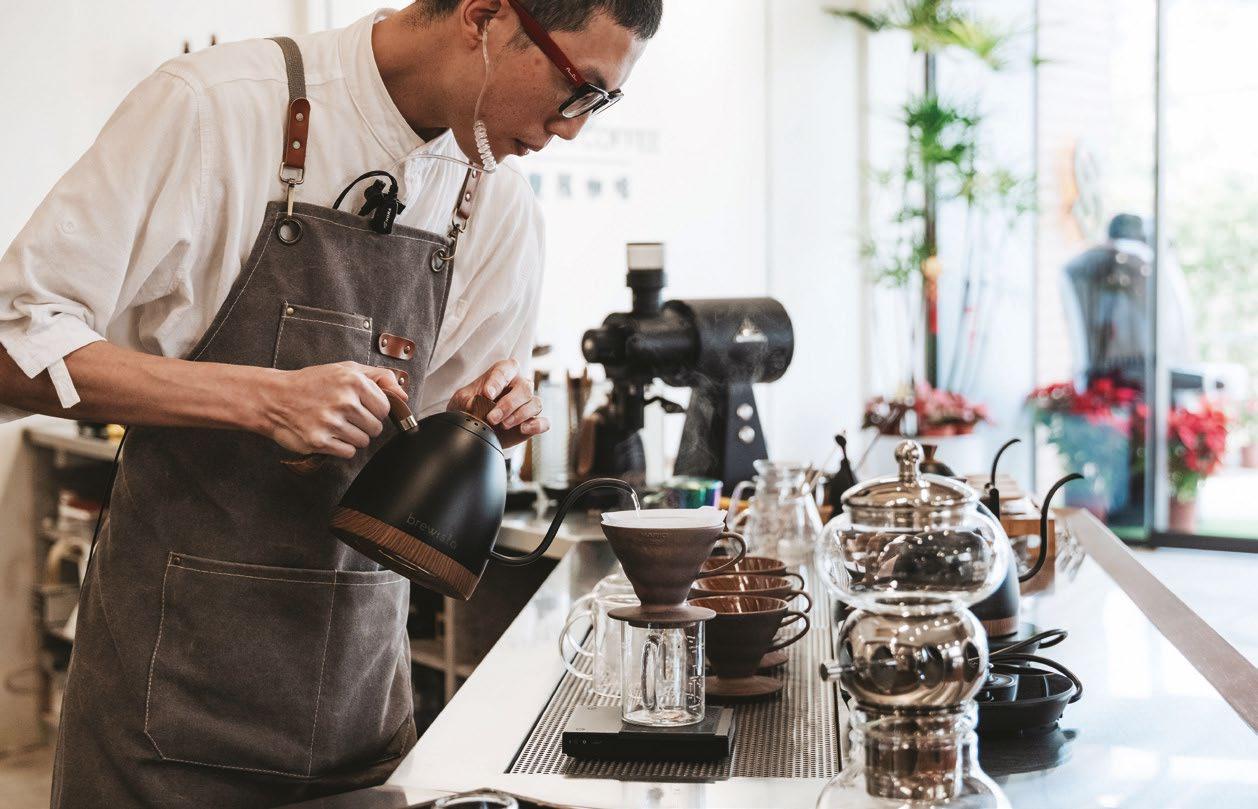
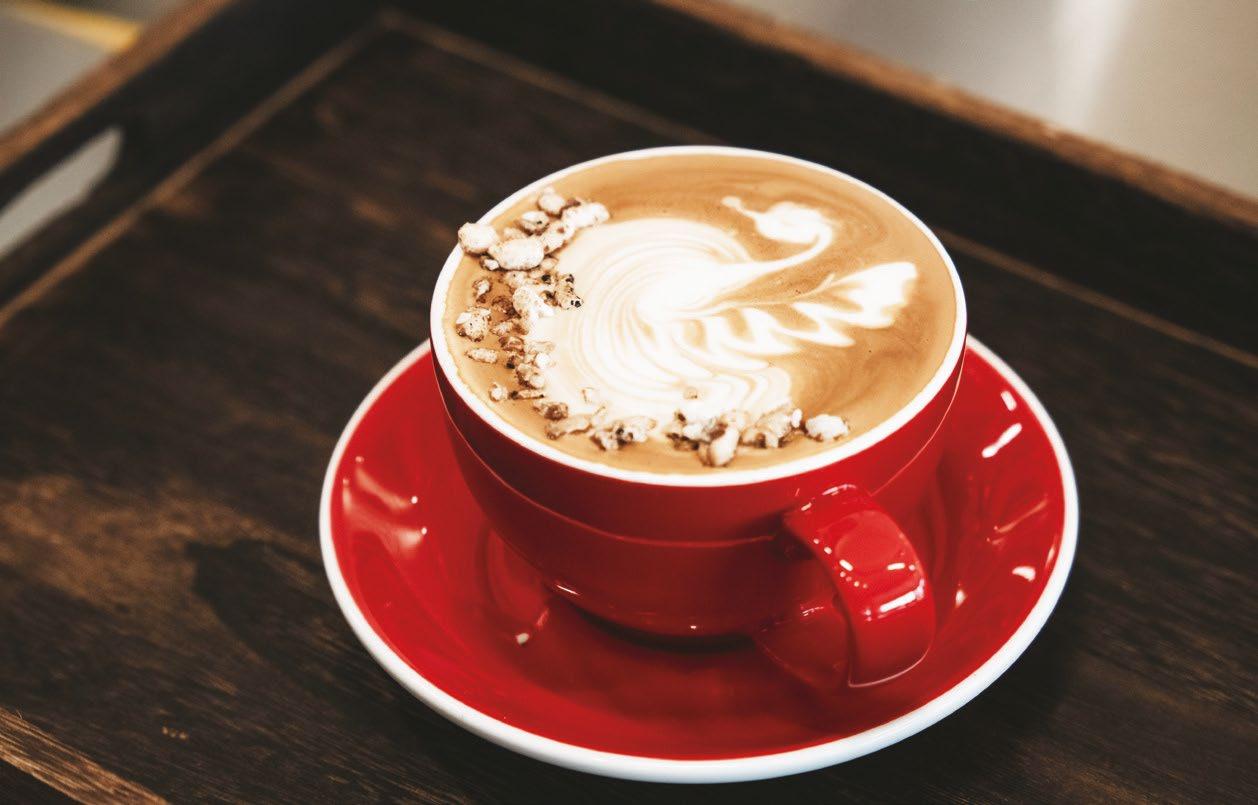 Expert barista at work
Huisun Coffee Brand Store
Puffed rice latte
Expert barista at work
Huisun Coffee Brand Store
Puffed rice latte
26 TRAVEL IN TAIWAN MAY/JUN 2024
Tart, cake, and creme caramel
NANTOU Puli
Ja Po Café
Where Hui Sun is all about bringing contemporary coffee culture to the countryside, Ja Po Café leans heavily into a rustic image. Located close to the wellknown Chung Tai Chan Monastery along quiet Nantou County Road 73 (about 6km northwest of central Puli town), this onewoman enterprise is the antithesis of city living. The name Ja Po comes from the Hakka word for maternal grandmother, and the premises embody traditional Hakka frugality mixed with a modern interest in eco-friendly upcycling. Orchids spill from repurposed scooter helmets, cooking pans are reborn as outdoor lampshades, and a reservoir of succulents has taken up residence in an old shelving unit. The centerpiece is a ramshackle threestory treehouse perched in the arms of a Madagascar almond (its top-floor tea room is available with advance reservation), and out back, a surfeit of jabuticaba berries carpet the small backyard orchard – the

glistening sweet-sour tree grapes clinging to the branches, so ripe they come away with a single touch.
The café’s simple menu consists entirely of vegetarian light bites and sweets. We sampled the shepherd’s pie, which – while quite a dramatic reinterpretation of the dish my mum used to bake – was a very moreish mix of crumbly pastry, savory mushroom, and buttery mash garnished with snippings of home-grown mountain marigold. As for the cinnamon roll, that far exceeded my expectations, being much closer to the gooey-chewy confections I used to get back home rather than the overly bready ones that have become trendy in recent years. The food was washed down with organic black coffee under the mistrustful gaze of dog Doudou –one of a small menagerie of formerly homeless animals that have found a home at Ja Po. And as we headed too soon for our now-Taipei-bound car, I couldn’t help but think Doudou and her four-legged fellows had hit the jackpot when they found their forever home in this little patch of paradise.

HUI SUN COFFEE BRAND STORE ( 台灣惠蓀咖啡埔里品牌館 )
No. 395, Sec. 4, Zhongshan Rd., Puli Township, Nantou County ( 南投縣埔里鎮中山路四段 395 號 ) (049) 9291-5599
huisun.tw (Chinese)
www.facebook.com/huisuncoffee
JA PO CAFÉ ( 嫁婆 )
No. 66-1, Yongfeng Rd., Puli Township, Nantou County ( 南投縣埔里鎮永豐路 66-1 號 ) (049) 9242-3828
www.facebook.com/japo.cafe


Cinnamon roll

ENGLISH AND CHINESE
Ailan Interchange 愛蘭交流道
Chung Tai Chan Monastery
中台禪寺
Guoxing 國姓
Hutou Hill 虎頭山
Puli 埔里
Puli Basin 埔里盆地
Puli Township 埔里鎮
Liyu Lake 鯉魚潭
Sun Moon Lake 日月潭
Yushan Ailan 16-Year Aged Liquor
玉山窖藏 16 年愛蘭白酒
MAP
Treehouse
Teahouse building
Shepherd's pie
NANTOU Puli 27 TRAVEL IN TAIWAN MAY/JUN 2024

Landlocked Mountain Playground
Cycling, Railway Travel, and High-Mountain Exploring in Nantou County
Nantou County feels quite different from all other counties in Taiwan. When visiting the island’s sole landlocked county, your sense is that you’ve entered a hidden-away mountain bastion, accessed via gaps between high peaks on the north, east, and south sides, lower on the west through which most visitors enter. You feel an immediate sense of discovery and adventure after arriving. The tourist-adventure possibilities in this article follow three themes: cycling at beguiling mountain-surrounded Sun Moon Lake, railway travel on the scenic Jiji Line, and high-mountain exploring at lofty-perch Qingjing Farm and Hehuanshan (Mt. Hehuan).
NANTOU Themed Tours 28 TRAVEL IN TAIWAN MAY/JUN 2024
TEXT RICK CHARETTE PHOTOS VISION
Tour 1 – Cycling Sun Moon Lake
Located close to Taiwan’s geographical center and about 750m above sea level, Sun Moon Lake (www.sunmoonlake.gov.tw), is one of the island’s most iconic scenic attractions. The renowned round-lake biking route, about 30km in length, often makes lists of the world’s most scenic bicycling destinations – the CNN Travel website has described it as one of the world’s top 10 “cycling routes that’ll take your breath away.”
You can cycle much of the lake’s west side right beside the emerald-green waters –sometimes seemingly flying along overhead –on a long (14km) dedicated bikeway. The full lake circumnavigation is accomplished by using the round-lake highway on the hilly east side, which involves some climbing; the highway has low motor-vehicle speed limits. There’s one long dedicated bike-path section along this length. Numerous bike-rental operations vetted by the Tourism Administration are found along the route – at the Xiangshan Visitor Center and the two tourism-focused villages on the lake’s north and south shores, Shuishe and Ita Thao.
The lake’s scenic focal points include Lalu

Island , visible from many vantage points along the west and north sides. This is sacred ground for the area’s native people, the Thao, who had a key village here before waters were raised last century as part of a major hydroelectricity project. Regular yacht-tour cruises launched from the Shuishe and Ita Thao piers circle the island in-close. Other west-side bikeway high points include the dynamic-design Xiangshan Visitor Center, which has an info-rich exhibit hall and fine glass-façade café overlooking a tranquil bay, and the nearby poetically comely Tongxin Bridge and Yongjie Bridge, known as the “wedding photo bridges.” There’s also the Xiangshan Scenic Outlook skywalk, reached via a branch boardwalk that seems to flow through treetops, high above the aforementioned bay.
Major sights fronting the lake’s east side are the magisterial, decoratively extravagant Wenwu Temple and the Sun Moon Lake Ropeway (www. ropeway.com.tw), which lifts you up to high-gliding big vistas on the way to popular Formosan Aboriginal Culture Village (www.nine.com.tw), located in a valley not far from the lake.
NANTOU Themed Tours 29 TRAVEL IN TAIWAN MAY/JUN 2024
Yongjie Bridge at Sun Moon Lake
Tour 2 – Railway Travel
Jiji Line
The short multiple-carriage trains (some colorfully painted) that ply the scenic 29.7km Jiji Line operate like buses on a convenient local route, delivering tourists and locals between old settlements along the Zhuoshui River from the edge of the western plains to the foot of the mighty central mountains below Sun Moon Lake. Tourists use the frequent service for relaxed and inexpensive hop on/hop off expeditions through the river valley. The branch line, which runs between the towns of Ershui and Checheng, was created by the Japanese colonial government in the 1920s to transport materials for Taiwan’s first great hydroelectricity-generation project, encompassing up-mountain Sun Moon Lake and valley-bottom Checheng.
The massive hydro-facility works at Checheng are a wonder to behold, especially the suite of giant side-by-side pipes descending the mountainside at the village’s edge. Checheng also had a long period as a major logging center, and right in the village is the highly informative Checheng Wood Museum, a renovated timber-processing complex, where you can view an old timber mill, lake-sized

timber storage pond, and numerous other loggingera wood-built structures.
Just outside the town of Shuili is the touristfocused Shuili Snake Kiln (www.snakekiln.com. tw), a sprawling heritage facility perched on a hillside hidden by forest cover. In bygone days Nantou was a flourishing ceramics-production center. The compound’s facilities encompass the original kiln and a museum area, multimedia exhibition room, boutique, and breezy open-front coffee shop.
In Jiji Township, visit the quaint, cottageish Japanese-style Jiji Railway Station , a reproduction created after severe damage to the original in Taiwan’s infamous 921 Earthquake, and the mesmerically photogenic ruins of the original Jiji Wuchang Temple, which collapsed in on itself. Rent bicycles near the train station and head out along the sun-dappled Jiji Green Tunnel , a vivaciously green 4.5km tree-lined section of County Route 152, motor-vehicle traffic generally light, which has good spots to rest and take photos of passing trains.
NANTOU Themed Tours
Train on the Jiji Branch Line
Tour 3 – High Mountains
Qingjing Farm/Hehuanshan
Qingjing Farm (www.cingjing.gov.tw) and Hehuanshan are exceptionally popular alpine tourist destinations located on the Highway 14A section of the Central CrossIsland Highway. Though high and deep in the central mountains, both are easily reached thanks to Taiwan’s first-rate highway system. If self-driving, Qingjing is just 3.5hrs or so from Taipei, 1.5hrs from central Taichung. Among your varied bus options, perhaps most convenient is the Taiwan Tour Bus (taiwantourbus.com.tw) guided-tour service, vetted by the Tourism Administration, which offers a Qingjing/Hehuanshan outing.
Qingjing, at an altitude of about 1,750m above sea level, is one of Taiwan’s most visited recreational farms. The area’s unique quartet of enticements are wondrous mountain panoramas, alpine-farmland experiences, dramatically perched slope-hugging inns and homestays, and a vibrant Baiyi community. The farm was settled in the early 1960s by retired Nationalist soldiers who had been stationed in China’s Yunnan region after the Chinese Civil War; many had married women from the local Baiyi and other minority tribal groups. Taiwan’s highest-elevation skywalk, the gently curvaceous Qingjing Skywalk , flows uphill along steep pastureland slopes for 1.2km. At the Green Green Grassland , sheep and (sometimes) cattle graze on rolling mountaintop pastureland, and there are daily sheep-shearing/sheepdog shows and horse-riding shows.
Wuling , Taiwan’s highest public-road point at 3,275m and gateway to Mt. Hehuan’s various peaks via easyaccess roadside trailheads, is about an hour’s drive from the farm. Since the highway puts you just below the vertexes, the hike to the main peak requires only moderate fitness. The Hehuanshan Main Peak Trail , 1.8km one way, brings you to the 3,417m-altitude pinnacle, where you’ll enjoy grand panoramic views. Along the way you’ll see abandoned military facilities (until 2000 this was an off-limits zone) such as a barracks camp and camouflaged pillboxes.
ENGLISH AND CHINESE
Baiyi 擺夷
Checheng 車埕
Checheng Wood Museum 車埕木業展示館
Ershui 二水
Formosan Aboriginal Culture Village 九族文化村
Green Green Grassland 青青草原
Hehuanshan (Main Peak Trail) 合歡山 ( 主峰步道 )
Ita Thao 伊達邵
Jiji 集集
Jiji Green Tunnel 集集綠色隧道
Jiji Line 集集線
Jiji Railway Station 集集車站
Jiji Wuchang Temple 集集武昌宮
Lalu Island 拉魯島

Qingjing Farm 清境農場
Qingjing Skywalk 清境高空步道
Shuili (Snake Kiln) 水里 ( 蛇窯 )
Shuishe 水社
Sun Moon Lake 日月潭
Sun Moon Lake Ropeway 日月潭纜車
Thao Tribe 邵族
Tongxin Bridge 同心橋
Wenwu Temple 文武廟
Wuling 武嶺
Xiangshan Scenic Outlook 向山眺望平台
Xiangshan Visitor Center 向山行政暨遊客中心
Yongjie Bridge 永結橋
Zhuoshui River 濁水溪
Themed Tours 31 TRAVEL IN TAIWAN MAY/JUN 2024
Qingjing Skywalk
NANTOU

Suggested Morning/Afternoon/Evening Walk Itineraries
Central Taichung is one of the most pleasant urban centers in Taiwan to perambulate on foot. Planners have taken full advantage of the ample space available to create comfortable room along streets for pedestrians and have desiganed green spaces aplenty, including long green corridors. As a quality bonus, even right in the core there’s an unusual amount of lowrises, and buildings tend to be a bit further back from the street than in other city centers.
Taichung’s Calligraphy Greenway
TEXT RICK CHARETTE PHOTOS VISION blank plan Swinhoe Shenji New Village PARK2 Caowu Plaza Taichung Civic Square Park Lane by CMP National Museum of Natural Science Fantasy Story - Green Ray National Taiwan Museum of Fine Arts Zhongxin Market G-Soup
Calligraphy Greenway
Morning
Launch your morning promenade at the lengthy Calligraphy Greenway’s north end at the National Museum of Natural Science (www.nmns.edu.tw), opened in 1986. One of Taiwan’s finest science museums, this global-caliber facility has galleries dedicated to the subjects of science, life sciences, human cultures, and global environment. There is also a Space Theater, featuring a semi-spherical dome screen, in which science and ecological films are shown and planetarium sessions are held.
The museum’s adjacent bio-buzzing 4.5ha Botanical Garden is a forest of endemic plants penetrated via a web of cool, shady walkways. A transparent glass structure with exposed steel-pipe framing that resembles a monumental lunar-landing craft rises in the center above the forest’s canopy – the Tropical Rainforest Greenhouse. Stepping within, enter a humid simulated tropical rainforest complete with spraying waterfall, orchid cliff wall, and intermittent “rain” (i.e., a moisture-spray system). Among other treasures for your photo memories are 300-plus species of flowering plants, a 14m-long aquarium filled with giant Amazon fish species – including the incredible arapaima, one of our world’s largest freshwater fish – and a smaller aquarium world with an evil-looking piranha armada restrained from attack on innocent colorful tropical neighbors by an invisible glass wall.



800m 12min walk
A little south from the museum, clustered close to each other, are Park Lane by CMP, Taichung Civic Square, and PARK2 Caowu Square. Park Lane by CMP is a multistory one-time parking garage gracefully recast as an urban garden where nature and modernity harmoniously coexist. Its most salient feature is the façade’s 20m-tall vertical garden walls. The interior retail/culture space is divided according to theme – children, music, wine, etc.
Taichung Civic Square is a large lawn-centered park that serves as the stage for the acclaimed international Taichung Jazz Festival. The park is always abuzz with buskers and other entertainment on weekends/holidays.
In Taichung City tourism promotions
PARK2 Caowu Square is described as a “non-classic” park combining green vegetation and brand-recognition retail, dining, and liquid-refreshment outlets. At its heart is a spacious sunken plaza featuring wood flooring and a lush array of broad-leaf and desert plants. There’s also an irregular schedule of theme markets, cultural exhibits, and liveentertainment performances.
The greenhouse from the outside
PARK2 Caowu Square
Tropical Rainforest Greenhouse
33 TRAVEL IN TAIWAN MAY/JUN 2024
URBAN WALKS Taichung
8min550mwalk
Noon/Early Afternoon
You’ll have been on your feet for quite a spell now, and your tummy clock will without doubt be signaling you it’s time to sit down at a culturally interesting spot presenting good and filling food creations. An inspired solution –Fantasy Story – Green Ray – is to be found a short walk further south, along a peaceful lane a block-plus west of the greenway. Here, glass walls and exposed

steel framework have been dynamically introduced to a long-abandoned line of 12 traditional-style Chinese dormitory residences of red brick and ceramic-tiling roofs built over 70 years ago, used by the local water corporation. Tree and vine growth that had invaded the derelict structures have been aesthetically left in place in many corners. Among the dining options here are the CYS
Taichung beer bar (www.facebook.com/ cystaichung ), specializing in local and imported craft beers; the Tasty Hipster café, serving light meals and refreshing drinks; and the Dumpling Lab (www. facebook.com/dmplab ), known for its creative dumplings that come in six different flavors and can be combined with five different sauces.



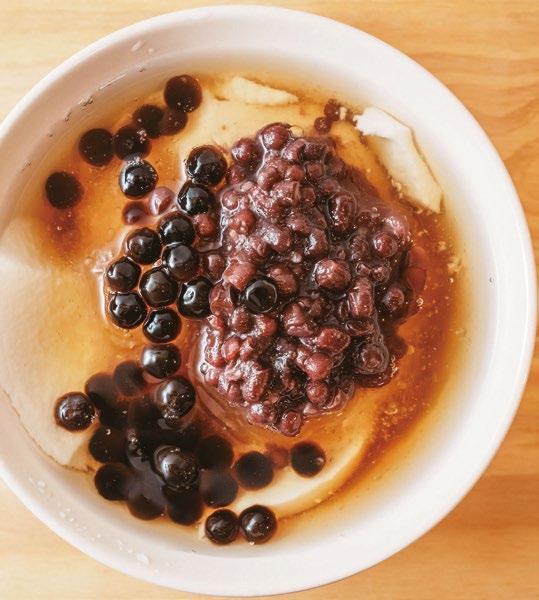

Shenji New Village is a neighborhood of rehabilitated lightyellow brick-and-concrete edifices topped with sloping ceramictiling roofs, dating to the 1960s, located two blocks directly south of Fantasy Story just west of the Calligraphy Greenway.
The cluster was fabricated as dormitory residences for Taiwan Provincial Government personnel (this government level is now defunct). The main street is paved with pebblestone and red brick, and paved footpaths lead through the other areas. At multiple points newly-constructed wooden staircases raise visitors up to second-story balconies and boardwalk-style walkways that connect buildings.
The community, for a time abandoned, today bubbles with trendy tourism-focused shops, studios, and other endeavors. The first wave of entrepreneurs was young cultural-creative personalities brought in under the “Catch a Star Youth Dream Taichung” program (www.tcdream.taichung.gov.tw; Chinese). The second wave consisted of owners of old shops or other types of businesses interested in new aesthetically updated locations or in trying brand-new ventures. Among your best options are a shop selling nostalgia items and postcards with cute images (Yushilab) and a tiny restaurant serving oily rice topped with Taiwanese-style sausage in mini rice steamers, as well as shaved ice and chocolate sweet-potato balls (La Jia Bong). There is also an Italian restaurant, a craft-beer bar, a creative studio inspired by window-grille patterns (ceramic wares, pins, purses, chopstick holders, etc.), and a studio crafting products featuring leather stitched to solid wood (coasters, vases, earrings, etc).
550m 8min walk
Fantasy Story – Green Ray
treat
Shenji New Village Icy
34 TRAVEL IN TAIWAN MAY/JUN 2024 URBAN WALKS Taichung
Sweet-potato balls
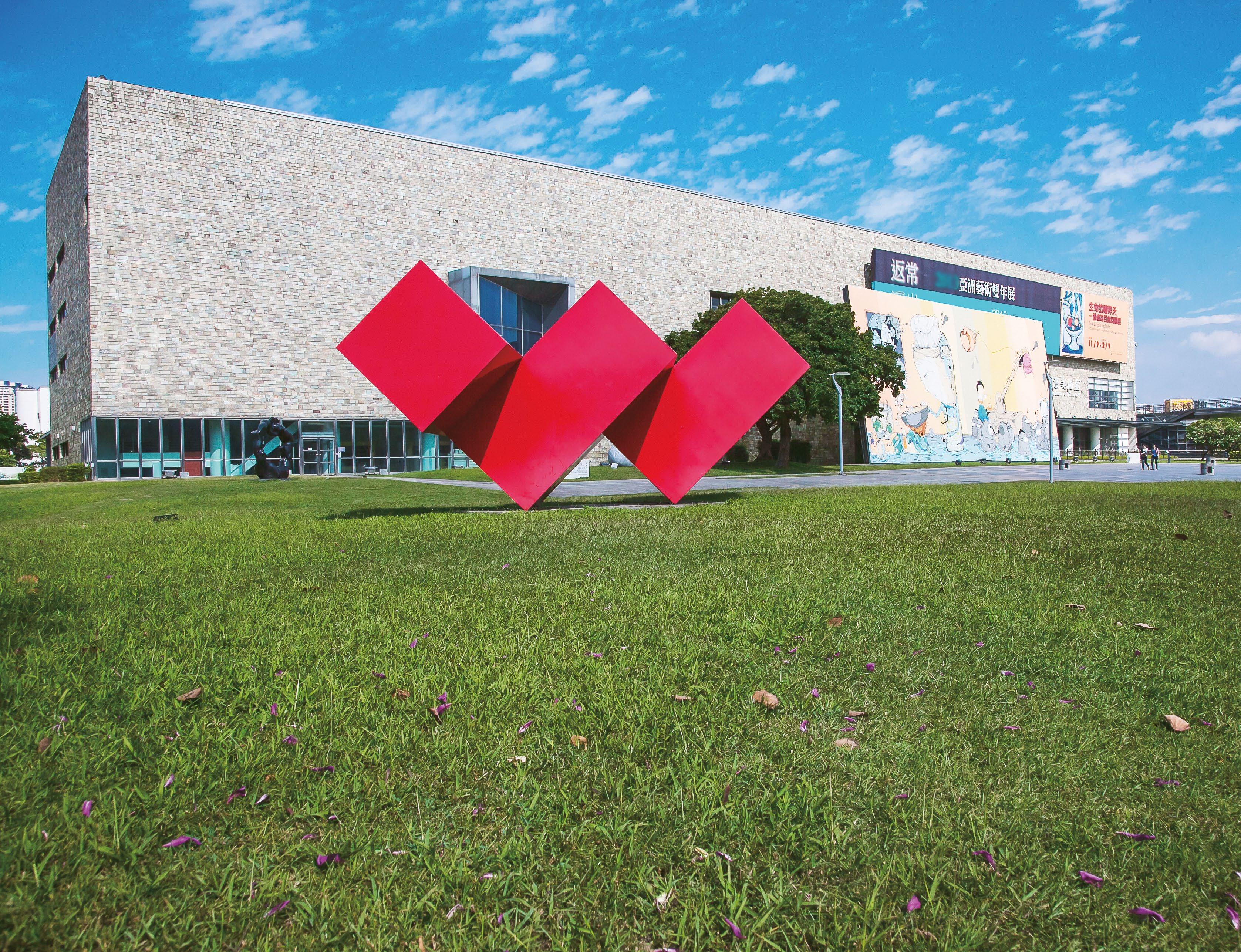
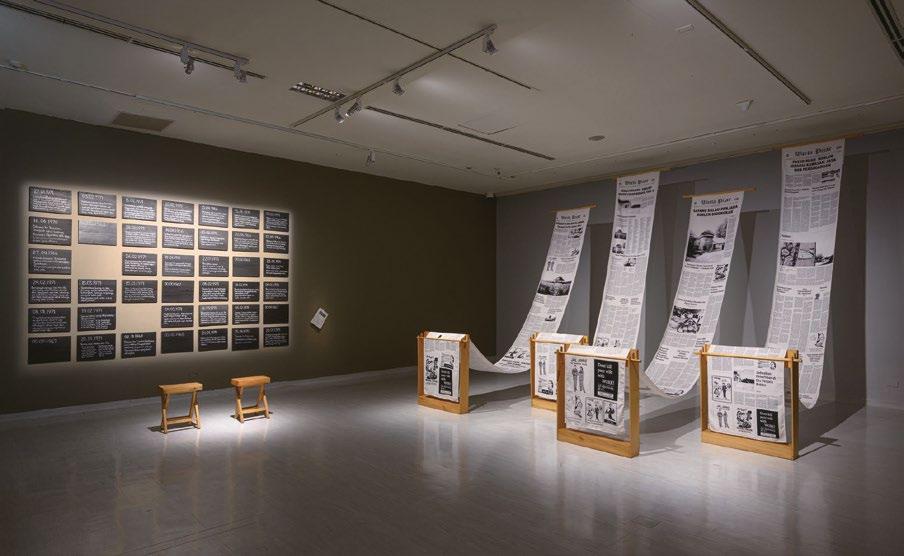

At the greenway’s south end is the grandiose National Taiwan Museum of Fine Arts (www.ntmofa.gov.tw), inaugurated in 1988. Taiwan’s first and only nationalgrade fine-arts museum, its vast collection today surpasses 19,000 works. The facility went through five full years of renovations after being damaged in the devastating earthquake that struck Taiwan in 1999, emerging even larger and with an even more visually dynamic interior and exterior.
The facility’s key focus is on modern and contemporary works by Taiwanese artists, and exploration of the singular characteristics of modern visual arts in Taiwan. It is set amidst an expansive, well-manicured grassy park dotted with arresting public-artwork sculptures that lures visitors and local denizens to lay down for a good read or a snooze. Inside are 15 exhibition halls. Other viewing stations include Gallery Street, U-108 Space: The Experimental Immersive Space of Techno Art, and Floating Isle: A VR Gallery. Among the varied educational spaces is the Taiwan Children’s Art Cave.
800m 11min walk
National Taiwan Museum of Fine Arts
35 TRAVEL IN TAIWAN MAY/JUN 2024 URBAN WALKS Taichung
Inside the museum
Late Afternoon/Evening
Zhongxin Market takes up a full (very small) city block right beside the Art Museum Parkway, a five-block green corridor that begins immediately south of the fine-arts museum, ending before the Liuchuan Canal. Once a busy traditional market, characterized by tight density of commercial enterprises each with generally small interiors, the warren has been transformed into a hub of creative spaces for artists and innovative entrepreneurs, bubbling with a retro feel and “hidden gem” shops. The retro feel is enhanced by the continued presence of some old-time enterprises as well, such as meat and vegetable vendors, generally open from early to mid-morning, and varied preparedfood stalls open for breakfast and lunch.
The market’s heyday was in the 1960s and 1970s when the land that is now the grounds of the fine arts museum was the site of dormitory facilities for the US military. Its fortunes waned after the US switched official ties to the PRC and American personnel in Taiwan were pulled out.
Two of the popular new ventures that have been set up within the market are G-Soup and Swinhoe. G-Soup is an eatery specialized in chicken soup. It opens for dinner only, reservations required, with 1-hour dining slots at 5:30, 6:30, and 7:30pm. The soup is hearty, with a different version – and only one – available each day. Side dishes such as soy-braised savories
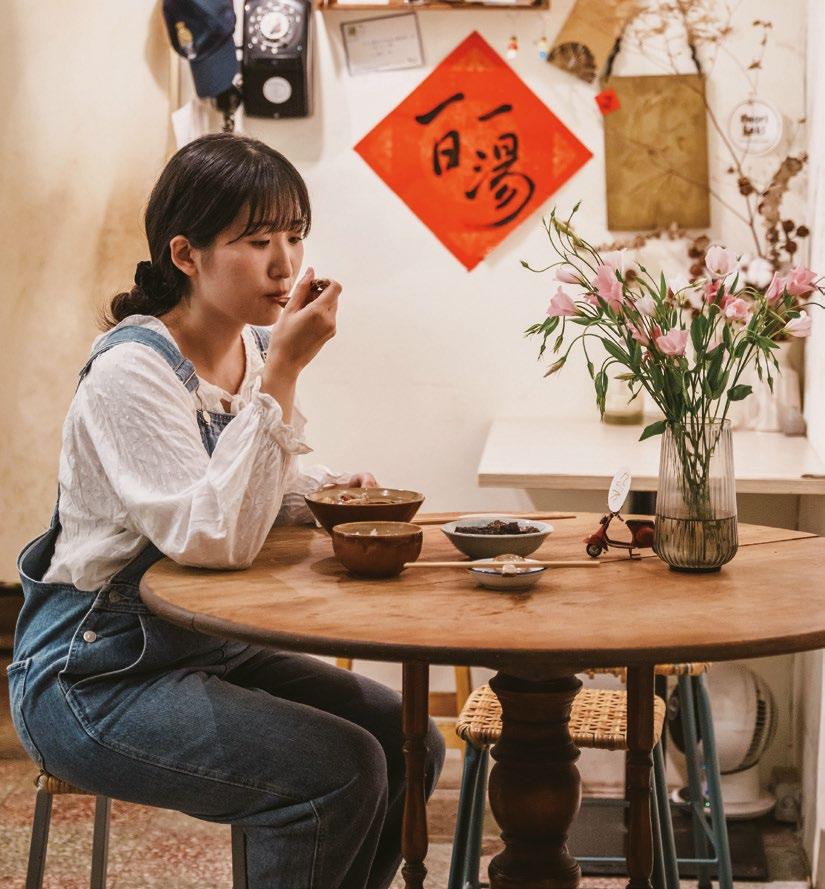
and ban fan with truffle cream are also available; ban fan is a rice dish similar to, but simpler than, Korean bibimbap.
Swinhoe (www.facebook.com/swinhoespace), a coffee shop, is named after Robert Swinhoe, an English diplomat and naturalist who pioneered the cataloguing of Taiwan’s fauna species in the 1800s. The exquisitely lovely Swinhoe’s Pheasant, also called the Taiwan Blue Pheasant, is named after him. The café is dedicated to the man’s work, the beauty of Taiwan’s bio-life, and to aesthetic living. The owner is a metalworking artist who has filled the café space with striking cuttlebone-casting artworks that are homages to Swinhoe and the living artworks of Taiwan’s natural environment that his adventures introduced to the wide world. 450m 6min walk



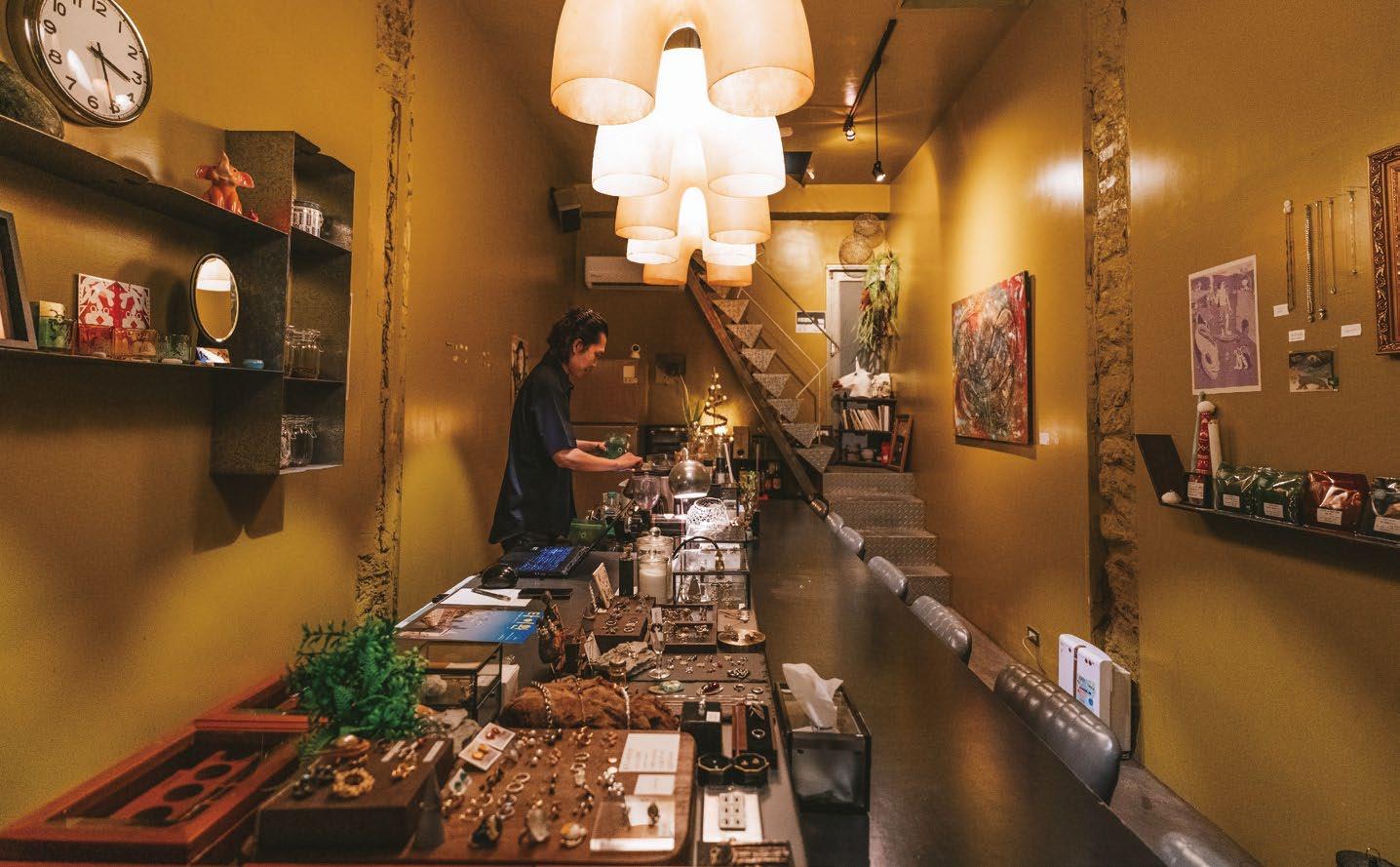 Zhongxin Market alley
Zhongxin Market alley
36 TRAVEL IN TAIWAN MAY/JUN 2024
G-Soup Swinhoe café
URBAN WALKS Taichung
At blank plan ( theblankplan.com ; Chinese), a concept-experiment undertaking right beside the parkway, the design-team owner-operators have taken the four floors of an old building and turned them, collectively, into an immersive-experience space. The levels are presented as spaces one enters with a “blank plan,” you as “blank slate” open to new and uplifting life aesthetics.
The first level is a “quiet green” tea-art experience space with vintage weathered wooden tables, wooden chairs from old-time theaters, and mottled, irregular gray walls to convey the passage of time. The rounded service bar is low, same height as the tables, to encourage customer interaction with the tea masters. The second level is a space of “day and night floating shadows,” baristas preparing hand-brewed fine coffees day-time, bartenders concocting themed, personalized wine-experience sets in the evening.
“Blue moonset” is the theme in the third-level retail and teaching space, where maverick-style, sustainableproduction creations by artists and indie designers are showcased.
350m 5min walk
There’s also a fine-living exhibit/ teaching space. “Sunshine landing” is the concept for the fourth level, an “interpretation space” with changing sensory-experience exhibits (entry fee).
When exploring this quarter, note that blank plan closes significantly earlier than the other attractions in this section, so you may consider visiting it first rather than last.



ENGLISH AND CHINESE
ban fan 拌飯
blank plan 留白計畫
Botanical Garden 植物園
Calligraphy Greenway 草悟道
CYS Taichung 啜飲室 台中
Fantasy Story – Green Ray 綠光計畫范特喜文創聚落
Dumpling Lab 製餃研所
G-Soup 几湯店
La Jia Bong 呷弁
Liuchuan Canal 柳川
National Museum of Natural Science 國立自然科學博物館
National Taiwan Museum of Fine Arts 國立臺灣美術館
Park Lane by CMP 勤美 誠品綠園道
PARK2 Caowu Plaza PARK2 草悟廣場
Shenji New Village 審計新村
Swinhoe 史溫侯
Taichung Civic Square 臺中市民廣場
Tasty Hipster 老聞青
Tropical Rainforest Greenhouse 熱帶雨林溫室
Yushilab 愚室解憂實驗所
Zhongxin Market 忠信市場

MAP
Blank plan
Second-floor café/bar
WALKS Taichung 37 TRAVEL IN TAIWAN MAY/JUN 2024
Dried-flower shop on third floor
URBAN

Hakka Heritage on Your Plate
Exploring Three of Taipei's Top Hakka Eateries
Taiwan’s Hakka people constitute a significant ethnic group, with roots that can be traced back to waves of immigration from across the Taiwan Strait during the 17 th century. More than 4.5 million descendants of those early settlers today form one of Taiwan’s most vibrant and visible minorities, known for time-honored culinary traditions and cooking techniques that make their food deliciously unmissable.
Many Hakka culinary creations reflect the self-sufficiency and resilience of the Hakka people, who often had to eke out a living in isolated mountain communities. With a focus on simplicity, the cuisine highlights the natural flavors of meats and vegetables. Hakka restaurants across the island beckon with rich authentic flavors, and from mouthwatering stir-fries to the culturally iconic lei tea (ground tea), there is something for everyone in Hakka fare.
Jin Shan Hakka Restaurant
A popular choice for Hakka food in Taipei, Jin Shan Hakka Restaurant was established in 1990. The owner moved to Taipei at the age of just 15, and first worked under the tutelage of different chefs, carefully honing his cooking skills and eventually becoming a chef in his own right. He then took over a humble porridge eatery bearing the name Jin Shan, and developed it into today’s thriving restaurant operation. The jin shan in the name translates as “golden mountain,” and is meant to symbolize the pursuit of high quality – represented by the mountain part (shan) – reinforced by the auspicious golden color ( jin).

GOOD FOOD Hakka Restaurants 38 TRAVEL IN TAIWAN MAY/JUN 2024
TEXT ASH BODEN PHOTOS CHEN CHENG-KUO, POWEI CHEN
GOOD FOOD Hakka Restaurants

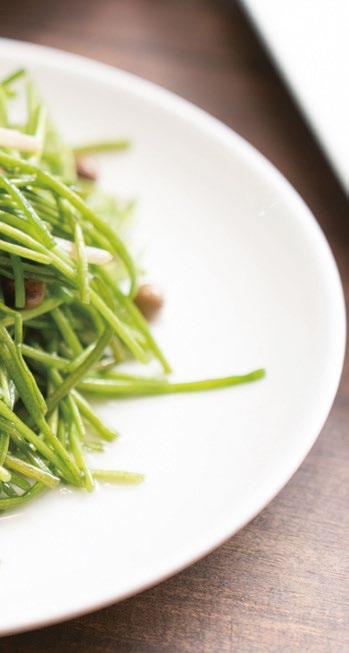
Snowflake with Pickled Cordia Dichotoma
2765-9906
Jin Shan Hakka Restaurant is perfect for groups, such as families or friends, with ample seating in the main dining area. In the rear of the restaurant are a couple of spacious private rooms with turntable-style tables catering to larger parties. A loyal customer base has been cultivated throughout the 30-plus years the restaurant has been in operation at the same location, and since it tends to be busy, reserving a table is recommended.
Ordering is made simple with a bilingual English and Chinese menu containing pictures of most of the dishes. For larger groups, ordering a set menu that includes the following house specialties is recommended: Simmered Leg of Pork, Hakka Baked Chicken in Salt, Braised Pork with Preserved Vegetables, and Chinese Ginger Chitterlings.
As the Simmered Leg of Pork is delivered to your table, you'll likely be struck by the size of the serving. A wonderful hunk of pork leg sits in a beautifully decorated bowl, surrounded by shredded bamboo shoots soaking in a moat of cooking juices. Portioned by the chef and liberally topped with cilantro and scallions, this is a true showstopper. Braised for hours, the pork leg has skin that is thick and full of flavor, protecting the meat from drying out. Juicy, decadent, yet remarkably light, this is one of the house specials for a clear reason.
DISHES
Braised Pork with Preserved Vegetables 梅菜扣肉
Chinese Ginger Chitterlings 薑絲大腸
Hakka Baked Chicken in Salt 客家鹽焗雞
Simmered Leg of Pork 紅燒蹄膀
No. 5, Alley 2, Lane 250, Sec. 5, Nanjing E. Rd., Songshan District, Taipei City ( 台北市松山區南京東路五段 250 巷 2 弄 5 號 ) 11:30am~2pm; 5pm~9pm
www.jinshan1990.com (Chinese)
www.facebook.com/jinshan1990

As is the Simmered Leg of Pork, the awardwinning Hakka Baked Chicken in Salt is a dish of elegance representing a culturally important cooking style of the Hakka people. Wrapped carefully and placed atop a mound of salt in a deep pan, then encased with more salt before being cooked, the chicken inside retains a stunning amount of succulence and flavor. A hint of salt remains but is balanced superbly with the delicious, responsibly sourced, crossbred chicken used in the dish.
The Braised Pork with Preserved Vegetables is presented nicely, with thinly cut layers of fatty pork belly laid carefully on top of traditionalstyle preserved vegetables. This dish is rich with pork flavors, but the preserved vegetables help to cut through some of that richness, balancing the dish well.
One of the most popular dishes, which you'll often find on Hakka restaurant menus in Taiwan, is the Chinese Ginger Chitterlings . Pork intestine is first cleaned and cut, then marinated with ginger, garlic, soy sauce, and various spices before being stir-fried to chewy perfection. Don't overlook this dish! It cuts through the richness of the other dishes with its vibrant sour and spicy flavors, enhancing and diversifying the entire meal.
Jin Shan Hakka Restaurant is a short walk from MRT Nanjing Sanmin Station in Taipei City’s Songshan District.
Chinese Ginger Chitterlings
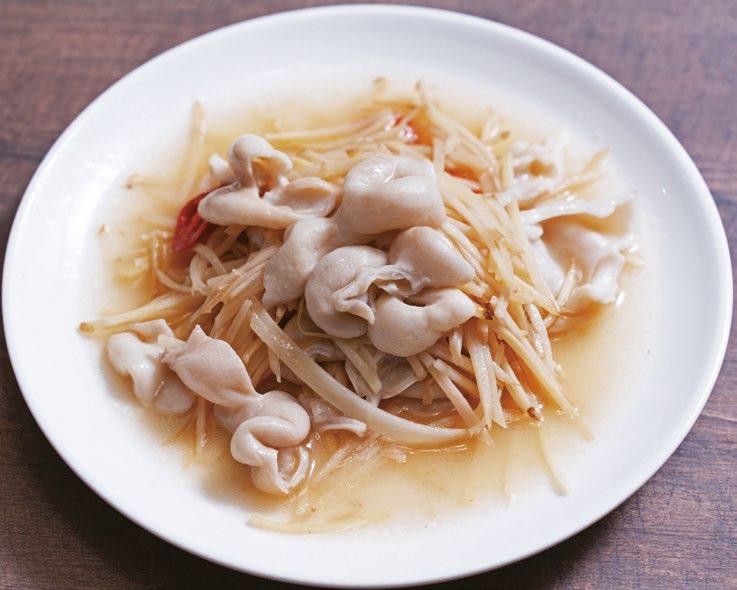
 JIN SHAN HAKKA RESTAURANT ( 金山客家小館創始店 ) (02)
Simmmered Leg of Pork
White Water
Entrance to Jin Shan Hakka Restaurant
Hakka Baked Chicken in Salt
JIN SHAN HAKKA RESTAURANT ( 金山客家小館創始店 ) (02)
Simmmered Leg of Pork
White Water
Entrance to Jin Shan Hakka Restaurant
Hakka Baked Chicken in Salt
39 TRAVEL IN TAIWAN MAY/JUN 2024
GOOD FOOD Hakka Restaurants
Liouduai Kitchen
This restaurant has been bringing Hakka food and flavors with a modern twist to the fore since 2011. You can feel comfortable walking in as an individual diner as well as part of a group of six or more, as it caters to groups and individual diners alike. As you head down the stairs from street level, you enter a modern dining space with such nods to Hakka culture as hand-woven hanging lampshades.
Under general manager Liu Guang-kai, Liouduai has evolved from a humble noodle shop on Leye Street in Taipei City’s Da’an District to an operation with several branches serving quality Hakka cuisine in Taipei and Taichung. The ongoing commitment to brand innovation and market expansion underscores the dedication to popularizing Hakka food and shining a spotlight on this distinctive cuisine.
With Hakka food, presentation often takes a back seat to ingredient quality, showcasing the practical approach to cooking preferred, while simplicity reins in flavor profiles, emphasizing the preservation of natural tastes. However, at Liouduai, while it is obvious that the retention of the cultural heritage of Hakka gastronomy is important, it is also clear that the chefs work hard at modernizing not only cooking techniques but also the ways of presenting each dish.
The restaurant focuses on healthy cooking methods, featuring low salt and oil, in addition to providing excellent value for money, while retaining traditional Hakka elements throughout. Ordering is easily navigated, with a bilingual menu and pictures available for each dish. Among the standout dishes are the Hakka Style Fried, Sauteed Tofu with Salted Egg, and unique Hakka-style Muscovado Mochi.


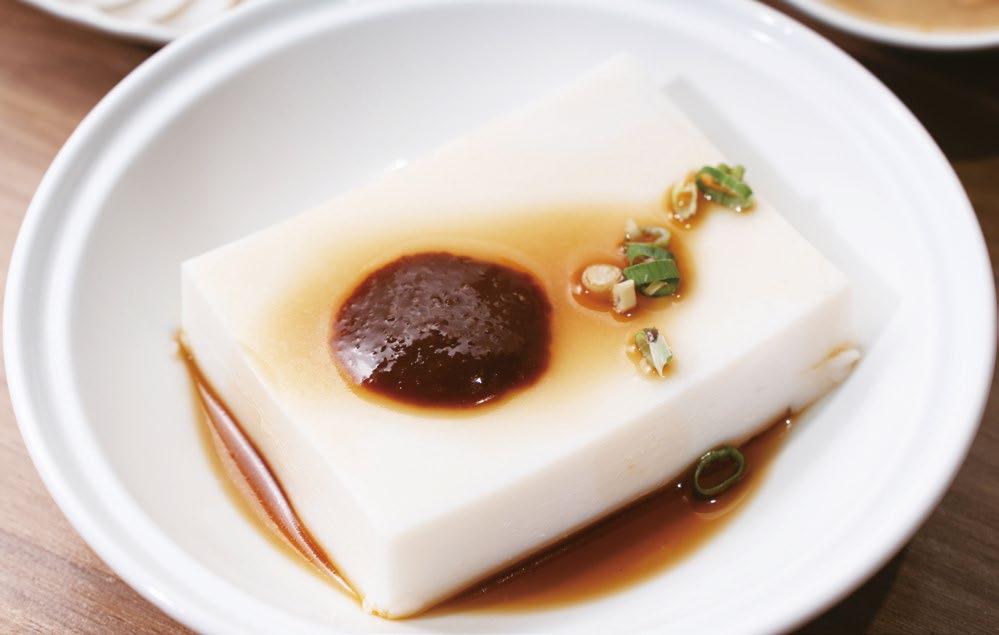
 Sauteed Tofu with Salted Egg
Hakka Style Fried
Peanut Tofu
Hakka food selection
Sauteed Tofu with Salted Egg
Hakka Style Fried
Peanut Tofu
Hakka food selection
40 TRAVEL IN TAIWAN MAY/JUN 2024
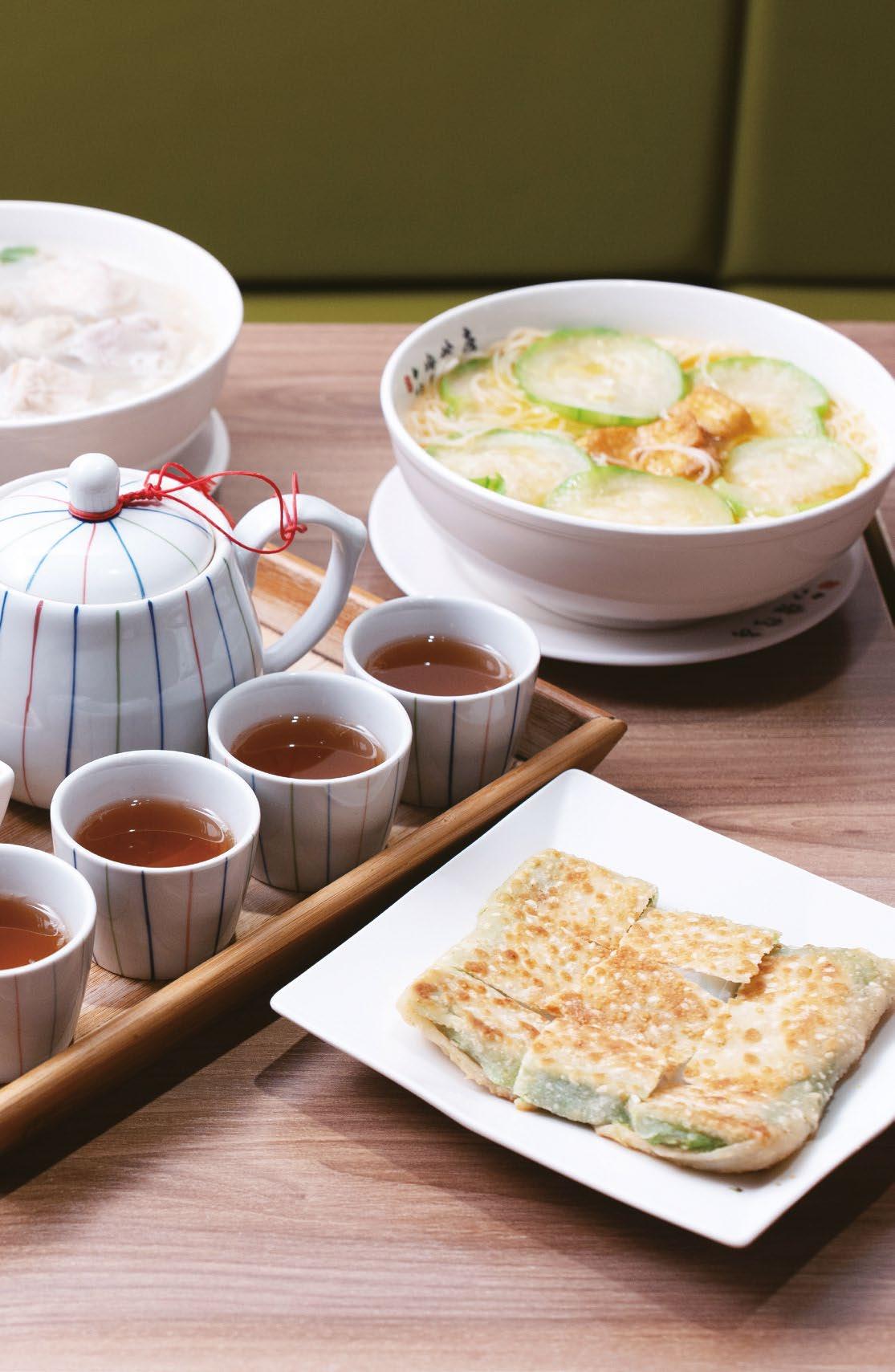

DISHES
Hakka Style Fried 客家小炒
Sauteed Tofu with Salted Egg 金沙南瓜豆腐
Hakka-style Muscovado Mochi 黑糖牛汶水
LIOUDUAI KITCHEN ( 六堆伙房 ) (02) 2563-6239
B1, No. 2, Sec. 2, Zhongshan N. Rd., Zhongshan District, Taipei City ( 台北市中山區中山北路二段二號 B1) 11:30am~10pm www.liouduai.com.tw (Chinese)

Hakka Style Fried is characterized by thinly sliced tofu, scallion, squid, and delicious slivers of pork belly. Balanced beautifully with light seasoning, all ingredients are stir-fried over high heat, allowing each element to retain its juiciness yet also take on a mild smokiness from the pan.
The Sauteed Tofu with Salted Egg is a delectable explosion of flavor at every bite. Chunks of soft and succulent tofu are first deep-fried to retain their juicy center while the skin takes on a golden color. The tofu chunks are then interspersed with chunks of soft-centered pumpkin and stir-fried together with salted egg and scallion.
For dessert, order the Hakka Style Muscovado Mochi . It arrives at your table in two bowls. One contains beautifully shaped mochi soaking in a Muscovado sugar syrup, and the other various seeds, including peanuts. Ridges line the inside of the second bowl, so you can grind the seeds using a wooden pestle. Once ground to a fine powder, using one of the provided small dessert forks you then dip the soaked mochi into the powder, pop the mochi in your mouth, and smile with glee as all the various flavors explode on your palate.
Liouduai has five locations, one near MRT Zhongshan Station in central Taipei; a branch specializing in lunchboxes within walking distance of MRT Nanjing Fuxing Station, also in the city; another near MRT Xinpu Station in New Taipei City’s Banqiao District; as well as two in the city of Taichung’s Xitun District.
Modern dining space
GOOD FOOD Hakka Restaurants 41 TRAVEL IN TAIWAN MAY/JUN 2024
Hakka Style Muscovado Mochi
Kitchen Restaurant
Sitting quietly and unassumingly on a backstreet in the heart of Taipei City, Kitchen Restaurant has served up Hakka culinary specialties for over 20 years. It’s the perfect place for groups of diners to enjoy reasonably priced Hakka cuisine set meals sitting around turntablestyle tables. Arriving in the evening, you'll be beckoned in by an alluring backlit designer-created logo outside, and inside you'll be warmly greeted by the owner, Liu De-xing. His energy and passion for Hakka food is infectious, and he is quick to offer his recommendations and suggestions as you get ready to order.
Upon sitting down at your table, you'll find a pot of hot tea ready and waiting, setting the tone for a comfortable and welcoming Hakka food experience, with great attention paid to service. While the lights above each table shine brightly, allowing the food to take center stage, lighting throughout the restaurant is less bright, allowing a warm and calm feeling to sink in.
The menu features Chinese, Japanese, and English for each item, ensuring that you will feel comfortable knowing exactly what you are ordering. Taking your order patiently, Mr. Liu will confirm that you have selected an appropriate amount based on the number in your party.
Among the delicious Hakka dishes offered, highlights include the Hakka Stir-Fry, Hakka-style Braised Pork with Pickled Vegetables, and Wrinkled Tender Tofu.
The Hakka Stir-Fry combines tofu, squid, celery, and pork in a light soy sauce with tiny dried sakura shrimp. Each bite offers fresh flavors that complement each other nicely, with bursts of sweetness coming through from the shrimp.



 Shrimp Balls with Salted Egg Yolk
Rice Flour with Flag Fish and Taro
Shrimp Balls with Salted Egg Yolk
Rice Flour with Flag Fish and Taro
Dining space
Hakka Restaurants 42 TRAVEL IN TAIWAN MAY/JUN 2024
Hakka Stir-Fry
GOOD FOOD


The Hakka-style Braised Pork with Pickled Vegetables is served on a long plate that is separated into two sections. On one side are delicately steamed buns, and on the other, you have generously sliced pork belly that has been braised low and slow to allow a silky smooth texture. Take a bun and carefully place the belly pork inside, on top of which you should put a modest portion of the scallion shavings and cilantro. Upon biting down on this succulently savory Hakka sandwich, the pillowy steamed bun gives way to a slice of belly pork that, while looking rich and fatty, tastes light and juicy. The addition of scallion and cilantro helps to draw away any sense of richness or overindulgence, imparting a fragrant freshness.
Lastly, the Wrinkled Tender Tofu features carefully fried tofu cubes in a light garlic-infused sauce, topped with scallion and Bonito flakes, offering subtle flavors and gentle textures. As you bite into the egg-enriched tofu, there's a mild resistance to the skin that then gives way to a silky tofu innard, and a fragrance of egg and tofu bursts into the air.
Kitchen Restaurant has two operations in Taipei City, one near MRT Nanjing Fuxing Station downtown and the other near MRT Dahu Park Station in Neihu District. Reservations are recommended due to high demand during peak times.
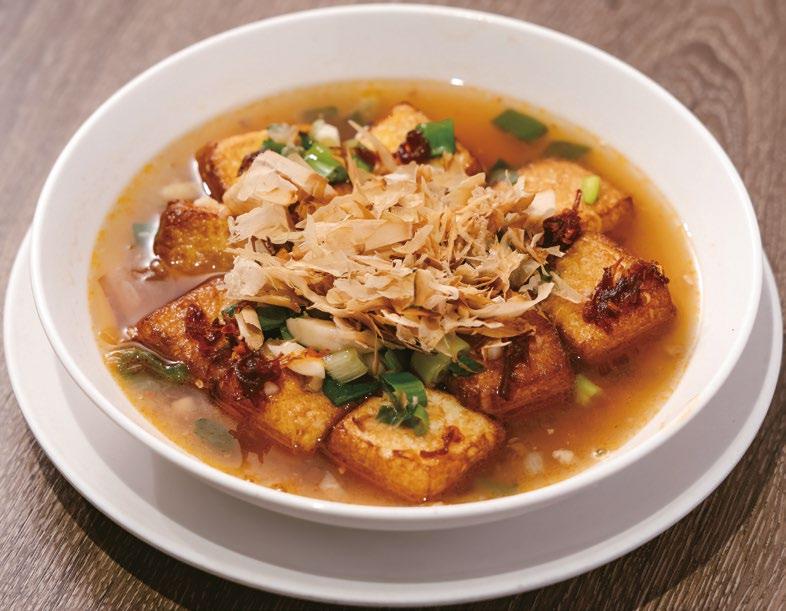
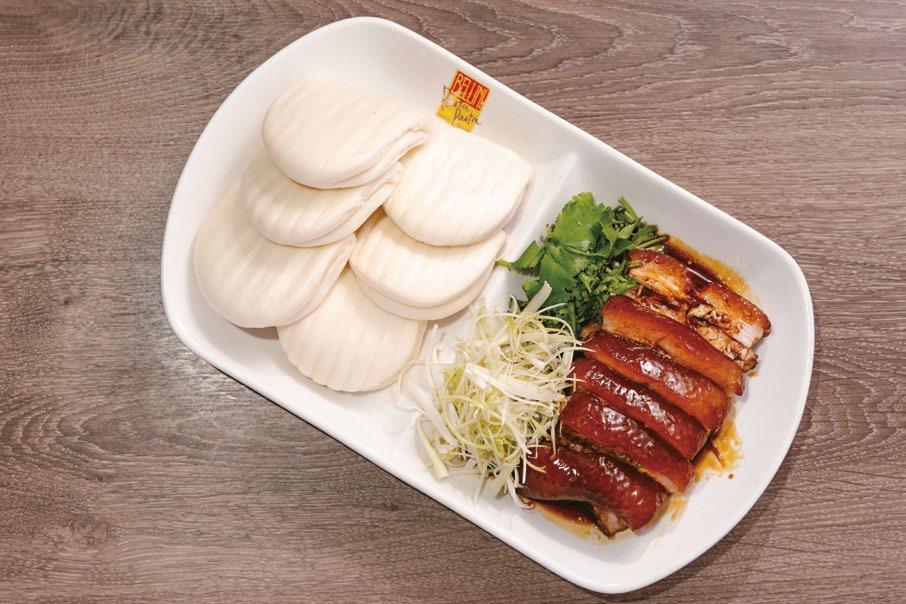

DISHES
KITCHEN RESTAURANT ( 廚房客家美食 ) (02) 2546-5186
No. 20, Lane 120, Dunhua N. Rd., Songshan District, Taipei City ( 台北市松山區敦化北路 120 巷 20 號 ) 11am~2pm; 5pm~9pm
ENGLISH AND CHINESE Hakka people 客家人
lei tea 擂茶
Liu Guang-kai 劉光凱
Liu De-xing 劉德興
Leye Street 樂業街
 Hakka Stir-Fry 客家小炒
Hakka-style Braised Pork with Pickled Vegetables 客家封肉 Wrinkled Tender Tofu 老皮嫩豆腐
Hakka Stir-Fry 客家小炒
Hakka-style Braised Pork with Pickled Vegetables 客家封肉 Wrinkled Tender Tofu 老皮嫩豆腐
MAP
Wrinkled Tender Tofu
Hakka Restaurants 43 TRAVEL IN TAIWAN MAY/JUN 2024
Hakka-style Braised Pork with Pickled Vegetables
GOOD FOOD
Taiwan’s Top Toppings
How the Locals Like Their Shaved
Shaved ice has been a favorite cold treat in Taiwan for more than a century, but ice alone would of course not be quite so popular – it is the ice in combination with the wide range of sweet toppings available at most stalls and eateries selling this delicacy. Following is a quick look at some of the most common of these toppings.



TEXT AND PHOTOS VISION Snow ice with fresh strawberries Shaved ice with assorted fruit LITTLE THINGS Shaved-ice Toppings 44 TRAVEL IN TAIWAN MAY/JUN 2024
Ice

It is not surprising that Taiwan, a subtropical/ tropical island, has its fair share of localstyle ice treats that visitors should certainly try during the hot days of the year. These include, among others, shaved ice, snow ice, popsicles, and bapu ice cream (bapu is the sound mobile ice-cream vendors make with their vehicle horns).
Shaved ice is especially popular as a treat to beat the heat. While eating ice to cool down was known throughout ancient times among rich people in northern China who could afford cellars to store ice “harvested” during the winter and keep it there until the hot season, the common people in China and Taiwan had to wait until the invention of refrigeration in the 19 th century and its proliferation around the world to get a taste. The technology to make ice was introduced to Japan in 1883 and arrived in Taiwan not long after. The custom of eating shaved ice was then made popular by the Japanese during their colonial rule of the island (1895~1945). Before that, remedies to cool down were usually non-iced drinks made by mixing ingredients such as herbal jelly (Chinese mesona), fig seed jelly (aiyu; unique to Taiwan), short rice noodles (mitaimu), and almond tea (xingren cha) with sugary water.
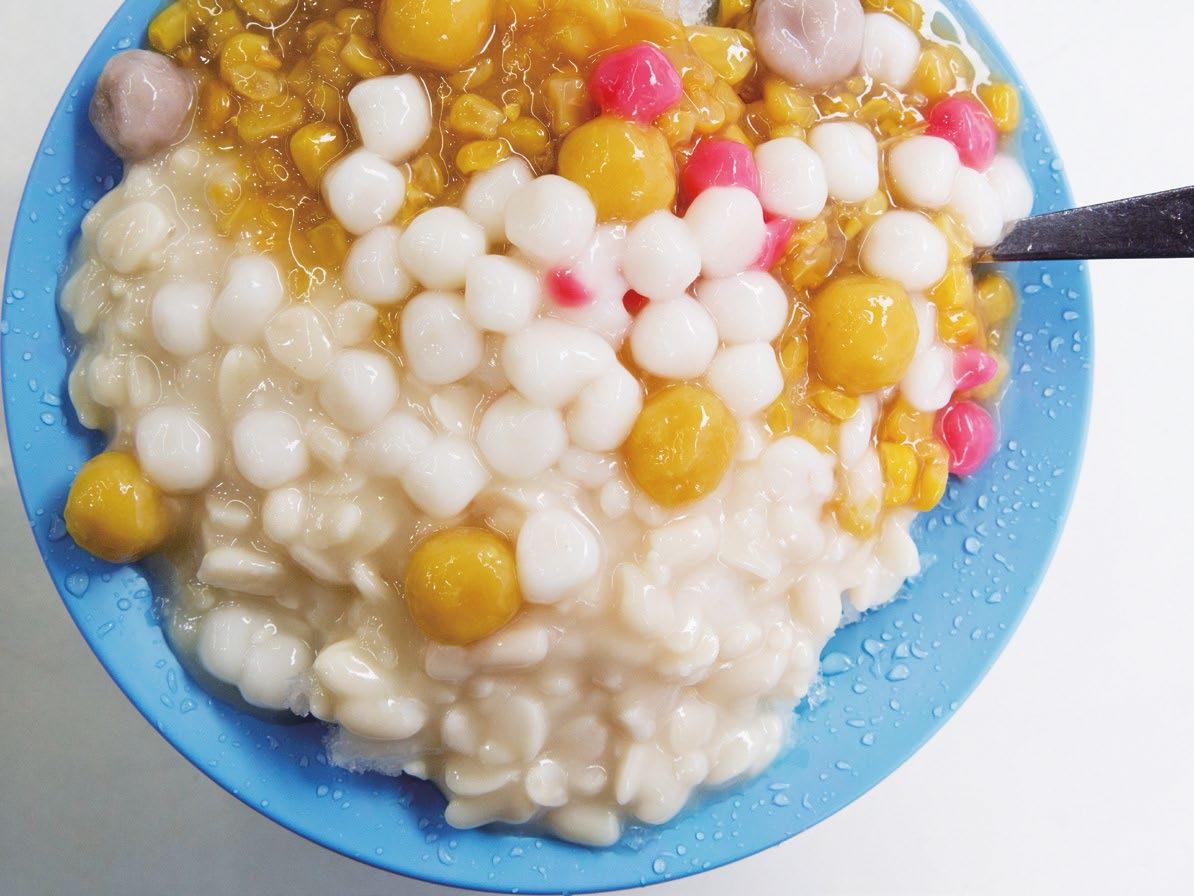
In the early days of shaved ice in Taiwan, blocks of ice were shaved using a special apparatus (as is still done today) and flavor was added by sprinkling a bit of banana oil and some sugary water on top. As time passed, other toppings tried by vendors and accepted by consumers have included Taiwan-cultivated adzuki beans, mung beans, peanuts, and taro, as well as fresh fruits such as pineapple and guava and preserved fruits such as plums and star fruit.
Adding processed foods, other than preserved fruit, as toppings began in the 1970s when vendors started to offer things like starch jelly, tapioca pearls, and mitaimu, then coconut gel and egg pudding.
In 1997, Taiwan’s shaved-ice scene experienced somewhat of a revolution, initiated by an ice shop on Taipei City’s Yongkang Street. The founder of Ice Monster had the brilliant idea of heaping copious amounts of fresh mango and a ball of mango ice cream on top of his shavedice servings and sprinkling them with condensed milk. This novel variation became an instant hit with local ice lovers and, soon, with foreign tourists as well. The shop also started to offer a similar type of ice using strawberry instead of mango, thus making sure that fresh, locally sourced fruit was served through most of the year. (In Taiwan, mango is harvested in the summer, while strawberry is during the winter.)
In a recent online survey by Social Lab, a local community trend and marketing insight research outfit, mango topped the list of most popular shaved-ice toppings, showing that the popularity of this mouthwatering combination has not waned since the late ’90s despite a never-ending stream of new toppings arriving on the scene from Taiwan’s ever-so-inventive ice-treat vendors.
Also in the top 10 of that survey were:
Tofu pudding and herbal jelly (both – like aiyu – often enjoyed as standalone refreshing treats, served without shaved ice)
Adzuki beans, peanuts, and taro (alongside mung beans regarded as classical shaved-ice toppings in Taiwan)
Tapioca balls (the black pearls people around the world are familiar with from drinking boba tea)
Starch jelly and pudding
Tip: If, when ordering shaved-ice treats in Taiwan, you are not quite sure what toppings to pick (you often get to pick three), choose the zonghe ( 綜合 ; “assorted”) option, if available, and the vendor will give you a mix of the most popular toppings.
ENGLISH AND CHINESE
adzuki beans 紅豆
aiyu 愛玉
almond tea 杏仁茶
bapu ice cream 叭噗冰
coconut gel 椰果
herbal jelly 仙草
Ice Monster 冰館
popsicle 枝仔冰
mitaimu 米台目
mung beans 綠豆
peanuts 花生 shaved ice 剉冰 / 刨冰
snow ice 雪花冰
starch jelly 粉粿
tapioca balls 粉圓

taro 芋頭 Yongkang Street 永康街
Shaved ice with peanuts and corn topping
45 TRAVEL IN TAIWAN MAY/JUN 2024
Pudding on top
“Select shop” is a term that originated in Japan, referring to boutique stores that sell lifestyle products from multiple brands in addition to in-house goods. In contrast to fast-fashion chains, select shops are carefully curated and often introduce consumers to unique up-and-coming brands and trends.

The Craft of Cultural Scavenging
Select Shop Earthing Way Breathes New Life into Old Objects and Traditional Crafts
TEXT HAN CHEUNG PHOTOS POWEI CHEN
Shop owner Hsieh Hsin-han (Bio)
Earthing Way
Hand-dyed using sweet potato leaves, the flowing, asymmetrical-design earthen-green jacket Hsieh Hsin-han is wearing appears as if it could belong both in a fashion show and a farming village setting.
Pieced together with used fabrics from different eras, including kimono cloth, the garment encapsulates the aramono spirit of his fine-crafts select shop Earthing Way (aramono is a Japanese term that describes a raw, original state without processing or polishing). But the store’s goods are by no means unrefined, as much thought, skill, and traditional knowledge is given to the creation of each unique piece. A self-described man of many contradictions, Hsieh enjoys dualities – which manifest themselves in different ways in Earthing Way’s offerings, ranging from jewelry and clothing to everyday tools and containers to incense.
Hsieh chooses items that have cultural value, are made with eco-friendly and natural techniques, require a certain level of craftsmanship, and have a story to tell. He’s especially interested in the collaboration between humans and nature, one in which the creator does not attempt to control or alter the materials but instead conforms to their inherent properties. As a graphic designer and brand consultant (among the many other hats he wears), Hsieh also works with artisans to create new products.
“It’s those items that contain memories that are precious nowadays”
Consumers now growing tired of the impersonality of fast fashion, interest in such qualities has grown since Hsieh opened his venture in Taipei City’s history-rich neighborhood of Dadaocheng seven years ago. He’s seen a significant spike in visitors since the pandemic forced people to slow down and look inward. Even so, he laughs about the fact that his mother still asks him why he is selling a bunch of junk and is always dressed in “rags” or “pajamas.”
“It’s those items that contain memories that are precious nowadays,” Hsieh says. “When we throw things away after using them or when they get old, we lose our emotional connection with them. Natural materials change with use and time – for example, leather looks better with age. Such qualities cannot be achieved if we keep buying new things.”
Hsieh is drawn to the beauty of transience and the imperfections of old objects, noting that most of his selections have a sort of withered vitality. He moonlights as a live liquid projection artist for musical performances, where paint flows freely into random patterns.
“Just like you can’t control where the paint goes, you can’t fight against impermanence,” he says. “Wood rots, iron rusts, people age. We should accept this, but there's also a poignance in trying to futilely resist it.”
Since he runs a small shop, Hsieh can spend time narrating the details of each object to visitors. This is also lacking in the age of mass production, he laments, as salespeople seem to focus on what discounts they can offer rather than who created a product, how it was made, and why it is worth buying.
The jacket he wears, for instance, was made by Hermit Xiu, a “madman” who bases his designs on meticulous research about Taiwan’s past, in particular the plains indigenous peoples and the Japanese colonial rulers who brought Western influences to the island. His unusual choice of sweet potato leaf as a dyeing agent is quintessentially Taiwanese, as it is a commonly consumed vegetable. Each jacket is hand-sewn, one piece taking nearly two weeks to complete.
Hsieh wants Earthing Way to be somewhere between a gallery and a store, but as a former set designer and nightclub dancer, he also sees the space as a stage and each object as a performer. His job as a director is to let the objects shine.
“Taiwan has so many talented designers whose creativity and techniques can compete on a global stage. But they’re lacking a platform,” Hsieh says. “Even though we are a small shop, at least I can properly display them and introduce their stories to the right customers.”

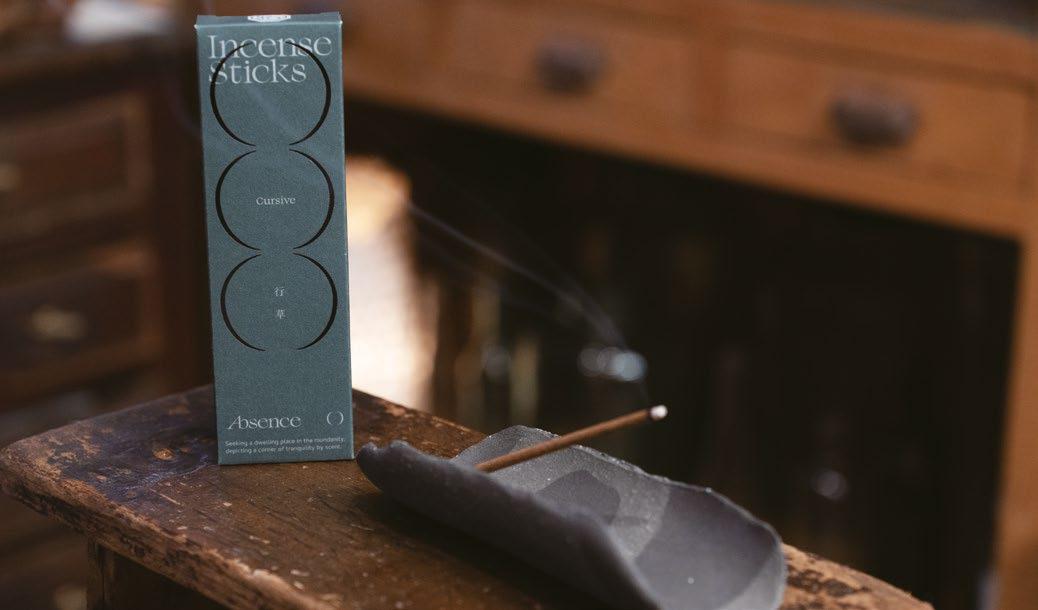
 Designer jackets
Incense sticks
Designer jackets
Incense sticks
EXPERT TALK Select Shop 47 TRAVEL IN TAIWAN MAY/JUN 2024
Candle holders



He points to a set of ceramic wares adorned with small ink illustrations by artist By Hua Hua, noting the contradictions that make the artwork intriguing. The drawings are based on an influential 17th-century Chinese painting manual, but some details are handled in a contemporary manner. And although By Hua Hua treats creation as a form of meditation, the resulting product is quite whimsical and offbeat.
“Just like how ceramics become such calm, serene objects after being fired in extreme heat, I accept the aesthetics resulting from these clashes,” he says.
Chen Ying-ting’s rust-dyed scarves are another example; the artist uses rust water from ordinary objects such as scissors and pliers to create blotchy patterns on plant-dyed fabric.
“It’s actually quite unconventional how she uses dirty water from everyday tools and turns it into a refined craft,” Hsieh says.
A popular in-house product is a series of ceramic vessels that contain candles made with traditional Chinese medicine. It’s created in conjunction with neighborhood vendors.
“These sorts of containers were once used to store herbs for traditional Chinese medicine, but because fewer people buy this kind of medicine today, we create aromatic candles using the containers to preserve this part of our culture,” Hsieh says.
The entrepreneur’s curation has earned numerous laudatory labels from the media, such as “rural revival aesthetics,”
EARTHING WAY ( 地衣荒物 )
No. 34, Minle St., Datong District, Taipei City ( 台北市大同區民樂街 34 號 ) (02) 2550-2270 Wed. ~ Sun. 12:30pm~7:30pm earthingway.waca.ec (Chinese) www.facebook.com/D1H5earthingway www.instagram.com/earthingway

“As scavengers, we retrieve things that are about to be t hrow n away, and give them a new life”
“Taiwanese-style wabi-sabi,” and “cultural modeling movement.” He’s often asked, “Are you selling old new things or new old things?” Hsieh, however, prefers the term “cultural scavenging.”
“As scavengers, we retrieve things that are about to be thrown away and give them a new life so they can be valued again,” he says. “Old items are often preserved because they have something worth cherishing, whether it be functionality or memories. Cultural scavenging is not just limited to old objects, but also to traditional crafts and ways of life that are on the verge of disappearing.”
While Earthing Way also carries Japanese products and draws much from Japanese culture, Hsieh says that the culture is just one of the diverse forces that have shaped Taiwan over the centuries. Han Chinese influences are also showcased, as well as artifacts created by different indigenous groups across the island.
“I accept the fact that my country has many different facets. In fact, these conflicting forces lead to somewhat of a balance,” he says. “I enjoy this conflict, it’s actually quite beautiful. I’d like to think that this store, at the very least, represents my worldview as a Taiwanese.”
ENGLISH AND CHINESE
aramono | 荒物
By Hua Hua | 白花花
Chen Ying-ting | 陳穎亭
Dadaocheng | 大稻埕
Hsieh Hsin-han | 謝欣翰
plains indigenous peoples | 平埔族

MAP
Ceramic wares
EXPERT TALK Select Shop 48 TRAVEL IN TAIWAN MAY/JUN 2024
Outside the shop Candles



TAIWAN EVERYTHING
EVERYTHING YOU NEED TO KNOW ABOUT TRAVELING IN TAIWAN!


Find Travel in Taiwan articles published in earlier issues, complemented with colorful images, Google maps, and links to our social media sites, including Youtube, Facebook, and Instagram, and informative sites of other bloggers in Taiwan.
Check out TAIWANEVERYTHING before you plan your next trip to Taiwan! taiwaneverything.cc


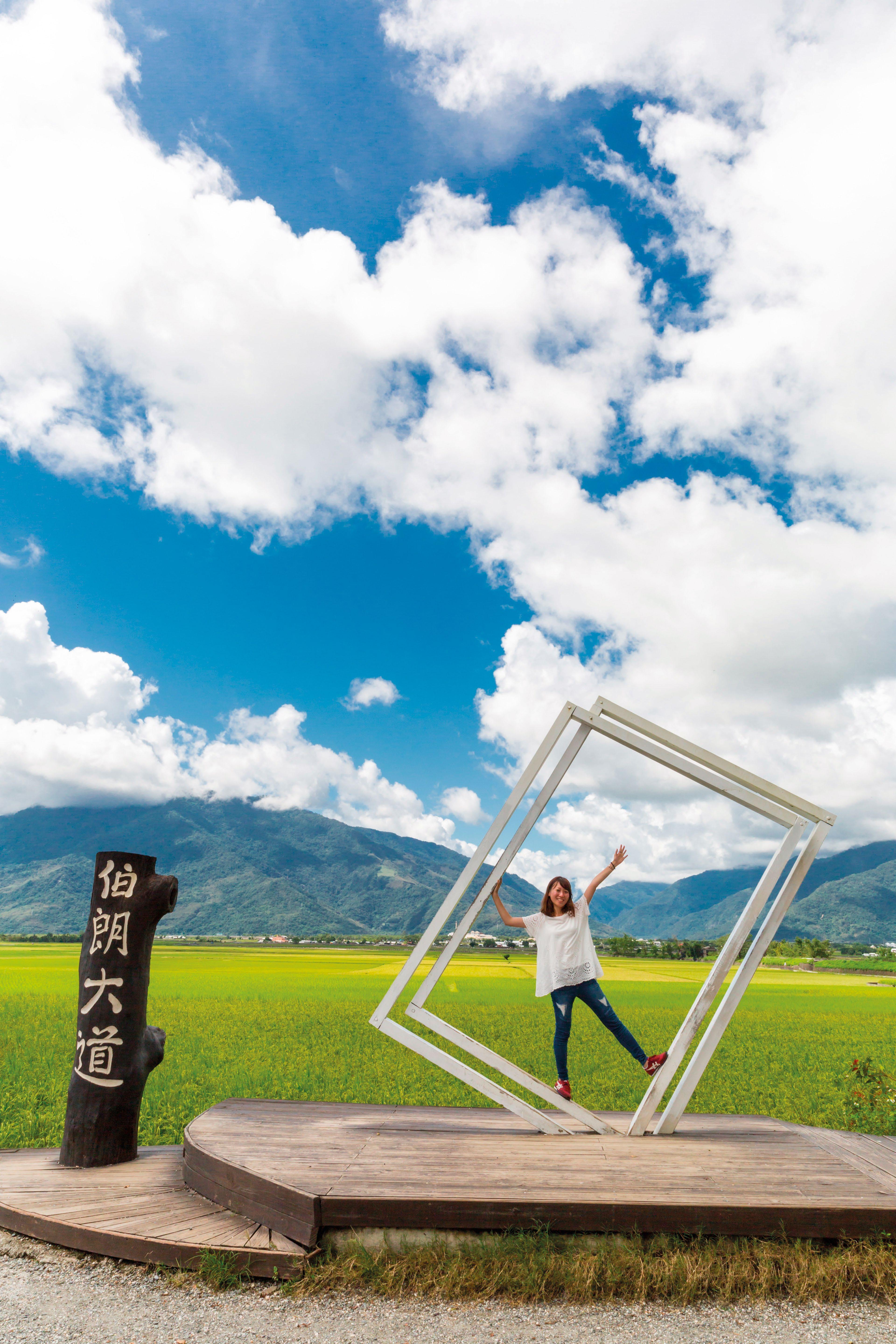








Facebook Youtube Website Hot! Stay / Eat / Buy
International Students Recruitment


79th in Asian University Rankings
431st in World Rankings (QS World University Rankings 2024)
1 1st in International Outlook among Taiwanese universities (Times Higher Education 2022)
9th in Education and Educational Research (Best Global Universities 2023)
Top 38 in Education (Times Higher Education 2023)
410+ partner institutions around the world

Semester Dates and Application Information
One of the four key cultivation universities in the Bilingual Education Program in Taiwan
The world-renowned Mandarin Training Center; online Mandarin courses offered (MTC Online)
Application Information, YouTube, and Instagram




• For the specific application schedule, please refer to the admission prospectus of the year.
• Online application only. Please refer to International Students Application website for details: https://bds.oia.ntnu.edu.tw/bds/apply
Popular and Recommended Departments/Institutes for International Students
Colleges Departments/Institutes Bachelor Master’s Doctoral Education Education
Program in Education
Liberal Arts Translation and Interpretation
Chinese as a Second Language
International Studies and Social Sciences
Management (AACSB-accredited) Management
●
2. Full tuition waiver (Bachelor’s program: 1 year; Master’s program: 2 years; doctoral program: 3 years) Scholarships
● Global Business and Strategy
1. Taiwan Scholarship (please contact the nearest diplomatic missions in your home countries)
Applications to Degree Programs – Office of International Affairs 886-2-7749-1272 , 886-2-7749-1284
https://www.ntnu.edu.tw/oia/
intlntnu@ntnu.edu.tw
Semesters Application Period Announcement of Admission Results New Student Registration Spring 2025 June 3 – July 31, 2024 October 2024 February 2025 Fall 2025 From November 2024 April 2024 September 2025 Spring 2026 From July 2024 November 2025 February 2026
● ● ●
● ● ●
●
● ●
● ● ●
Special Education
Transdisciplinary
English
● ● ●
●
International Human Resource Development ● Global Studies

























 ©Taitung County Govt.
©Changhua County Govt.
©Taitung County Govt.
©Changhua County Govt.

















 Paiyun Hiking Service Center
Lichen on pine tree
Paiyun Hiking Service Center
Lichen on pine tree

 Trail between Mt. Lulin and Mt. Linzhi
Trail between Mt. Lulin and Mt. Linzhi


























 Chocolate sales area on first floor
Fine-chocolate products
Chocolate DIY area
Chocolate sales area on first floor
Fine-chocolate products
Chocolate DIY area












 Expert barista at work
Huisun Coffee Brand Store
Puffed rice latte
Expert barista at work
Huisun Coffee Brand Store
Puffed rice latte


























 Zhongxin Market alley
Zhongxin Market alley










 JIN SHAN HAKKA RESTAURANT ( 金山客家小館創始店 ) (02)
Simmmered Leg of Pork
White Water
Entrance to Jin Shan Hakka Restaurant
Hakka Baked Chicken in Salt
JIN SHAN HAKKA RESTAURANT ( 金山客家小館創始店 ) (02)
Simmmered Leg of Pork
White Water
Entrance to Jin Shan Hakka Restaurant
Hakka Baked Chicken in Salt



 Sauteed Tofu with Salted Egg
Hakka Style Fried
Peanut Tofu
Hakka food selection
Sauteed Tofu with Salted Egg
Hakka Style Fried
Peanut Tofu
Hakka food selection






 Shrimp Balls with Salted Egg Yolk
Rice Flour with Flag Fish and Taro
Shrimp Balls with Salted Egg Yolk
Rice Flour with Flag Fish and Taro





 Hakka Stir-Fry 客家小炒
Hakka-style Braised Pork with Pickled Vegetables 客家封肉 Wrinkled Tender Tofu 老皮嫩豆腐
Hakka Stir-Fry 客家小炒
Hakka-style Braised Pork with Pickled Vegetables 客家封肉 Wrinkled Tender Tofu 老皮嫩豆腐









 Designer jackets
Incense sticks
Designer jackets
Incense sticks
























